Leadership and Management of Service Industry Assignment
VerifiedAdded on 2021/02/19
|19
|6294
|24
AI Summary
Contribute Materials
Your contribution can guide someone’s learning journey. Share your
documents today.
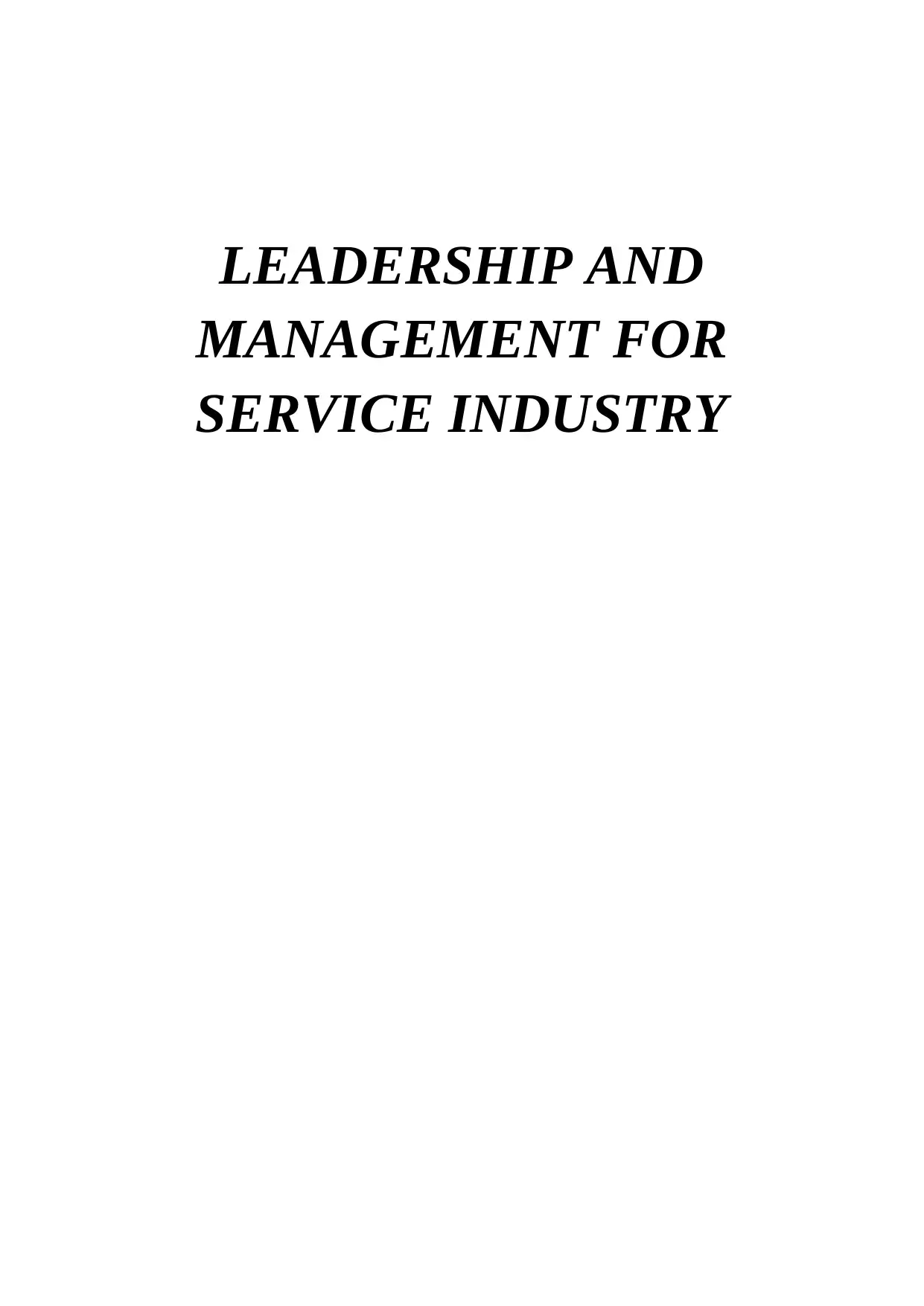
LEADERSHIP AND
MANAGEMENT FOR
SERVICE INDUSTRY
MANAGEMENT FOR
SERVICE INDUSTRY
Secure Best Marks with AI Grader
Need help grading? Try our AI Grader for instant feedback on your assignments.
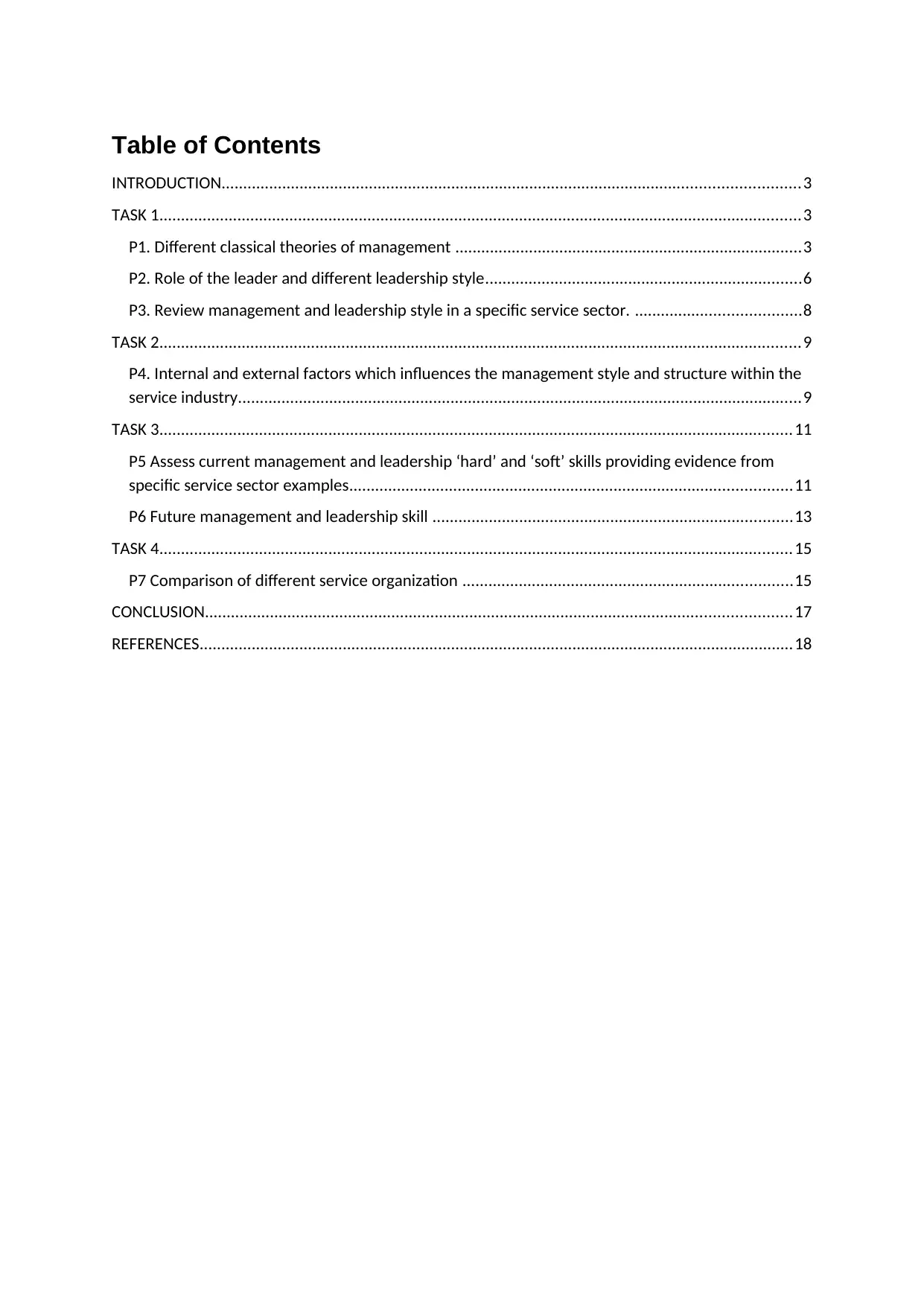
Table of Contents
INTRODUCTION.....................................................................................................................................3
TASK 1....................................................................................................................................................3
P1. Different classical theories of management ................................................................................3
P2. Role of the leader and different leadership style.........................................................................6
P3. Review management and leadership style in a specific service sector. ......................................8
TASK 2....................................................................................................................................................9
P4. Internal and external factors which influences the management style and structure within the
service industry..................................................................................................................................9
TASK 3..................................................................................................................................................11
P5 Assess current management and leadership ‘hard’ and ‘soft’ skills providing evidence from
specific service sector examples......................................................................................................11
P6 Future management and leadership skill ...................................................................................13
TASK 4..................................................................................................................................................15
P7 Comparison of different service organization ............................................................................15
CONCLUSION.......................................................................................................................................17
REFERENCES.........................................................................................................................................18
INTRODUCTION.....................................................................................................................................3
TASK 1....................................................................................................................................................3
P1. Different classical theories of management ................................................................................3
P2. Role of the leader and different leadership style.........................................................................6
P3. Review management and leadership style in a specific service sector. ......................................8
TASK 2....................................................................................................................................................9
P4. Internal and external factors which influences the management style and structure within the
service industry..................................................................................................................................9
TASK 3..................................................................................................................................................11
P5 Assess current management and leadership ‘hard’ and ‘soft’ skills providing evidence from
specific service sector examples......................................................................................................11
P6 Future management and leadership skill ...................................................................................13
TASK 4..................................................................................................................................................15
P7 Comparison of different service organization ............................................................................15
CONCLUSION.......................................................................................................................................17
REFERENCES.........................................................................................................................................18
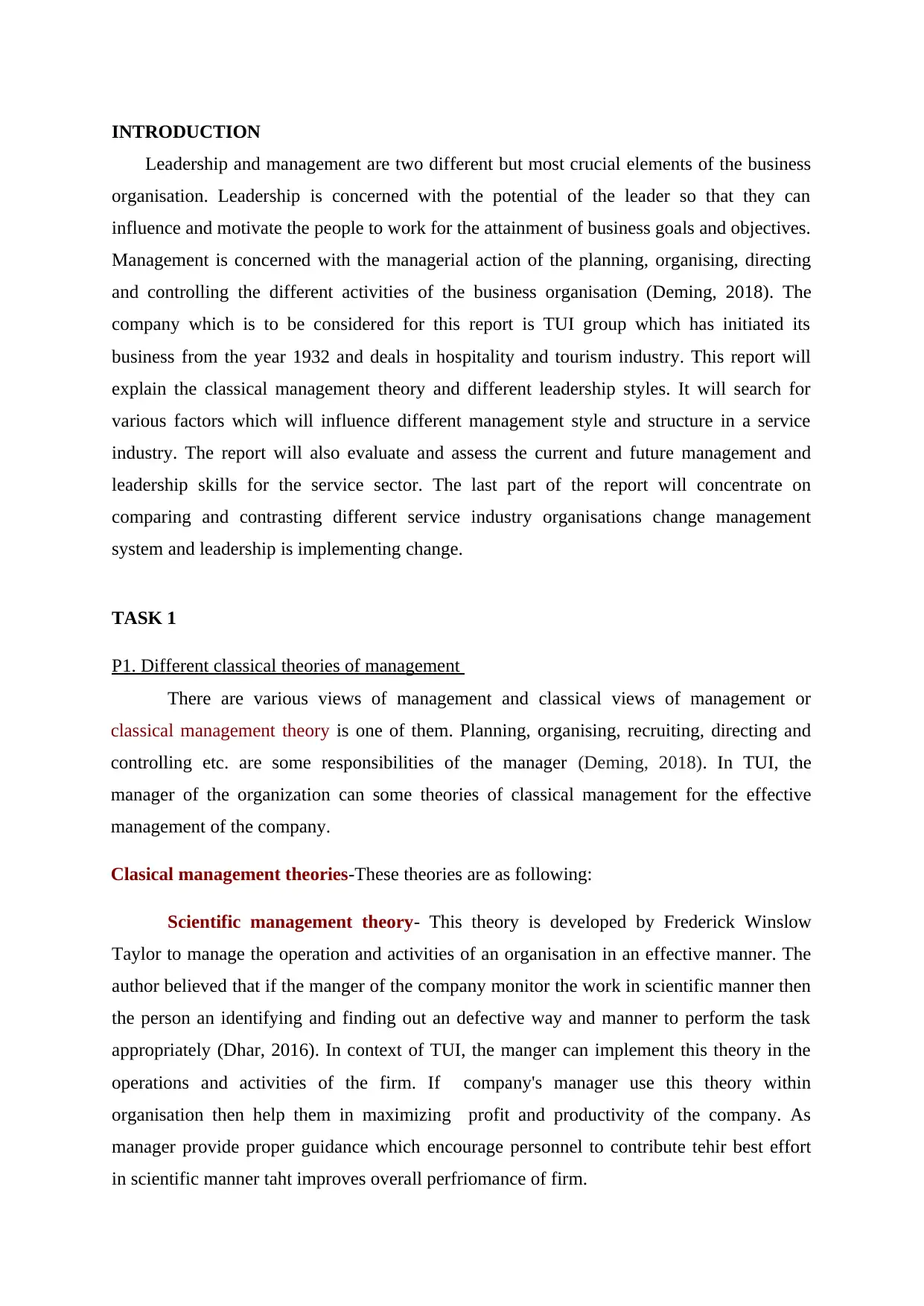
INTRODUCTION
Leadership and management are two different but most crucial elements of the business
organisation. Leadership is concerned with the potential of the leader so that they can
influence and motivate the people to work for the attainment of business goals and objectives.
Management is concerned with the managerial action of the planning, organising, directing
and controlling the different activities of the business organisation (Deming, 2018). The
company which is to be considered for this report is TUI group which has initiated its
business from the year 1932 and deals in hospitality and tourism industry. This report will
explain the classical management theory and different leadership styles. It will search for
various factors which will influence different management style and structure in a service
industry. The report will also evaluate and assess the current and future management and
leadership skills for the service sector. The last part of the report will concentrate on
comparing and contrasting different service industry organisations change management
system and leadership is implementing change.
TASK 1
P1. Different classical theories of management
There are various views of management and classical views of management or
classical management theory is one of them. Planning, organising, recruiting, directing and
controlling etc. are some responsibilities of the manager (Deming, 2018). In TUI, the
manager of the organization can some theories of classical management for the effective
management of the company.
Clasical management theories-These theories are as following:
Scientific management theory- This theory is developed by Frederick Winslow
Taylor to manage the operation and activities of an organisation in an effective manner. The
author believed that if the manger of the company monitor the work in scientific manner then
the person an identifying and finding out an defective way and manner to perform the task
appropriately (Dhar, 2016). In context of TUI, the manger can implement this theory in the
operations and activities of the firm. If company's manager use this theory within
organisation then help them in maximizing profit and productivity of the company. As
manager provide proper guidance which encourage personnel to contribute tehir best effort
in scientific manner taht improves overall perfriomance of firm.
Leadership and management are two different but most crucial elements of the business
organisation. Leadership is concerned with the potential of the leader so that they can
influence and motivate the people to work for the attainment of business goals and objectives.
Management is concerned with the managerial action of the planning, organising, directing
and controlling the different activities of the business organisation (Deming, 2018). The
company which is to be considered for this report is TUI group which has initiated its
business from the year 1932 and deals in hospitality and tourism industry. This report will
explain the classical management theory and different leadership styles. It will search for
various factors which will influence different management style and structure in a service
industry. The report will also evaluate and assess the current and future management and
leadership skills for the service sector. The last part of the report will concentrate on
comparing and contrasting different service industry organisations change management
system and leadership is implementing change.
TASK 1
P1. Different classical theories of management
There are various views of management and classical views of management or
classical management theory is one of them. Planning, organising, recruiting, directing and
controlling etc. are some responsibilities of the manager (Deming, 2018). In TUI, the
manager of the organization can some theories of classical management for the effective
management of the company.
Clasical management theories-These theories are as following:
Scientific management theory- This theory is developed by Frederick Winslow
Taylor to manage the operation and activities of an organisation in an effective manner. The
author believed that if the manger of the company monitor the work in scientific manner then
the person an identifying and finding out an defective way and manner to perform the task
appropriately (Dhar, 2016). In context of TUI, the manger can implement this theory in the
operations and activities of the firm. If company's manager use this theory within
organisation then help them in maximizing profit and productivity of the company. As
manager provide proper guidance which encourage personnel to contribute tehir best effort
in scientific manner taht improves overall perfriomance of firm.
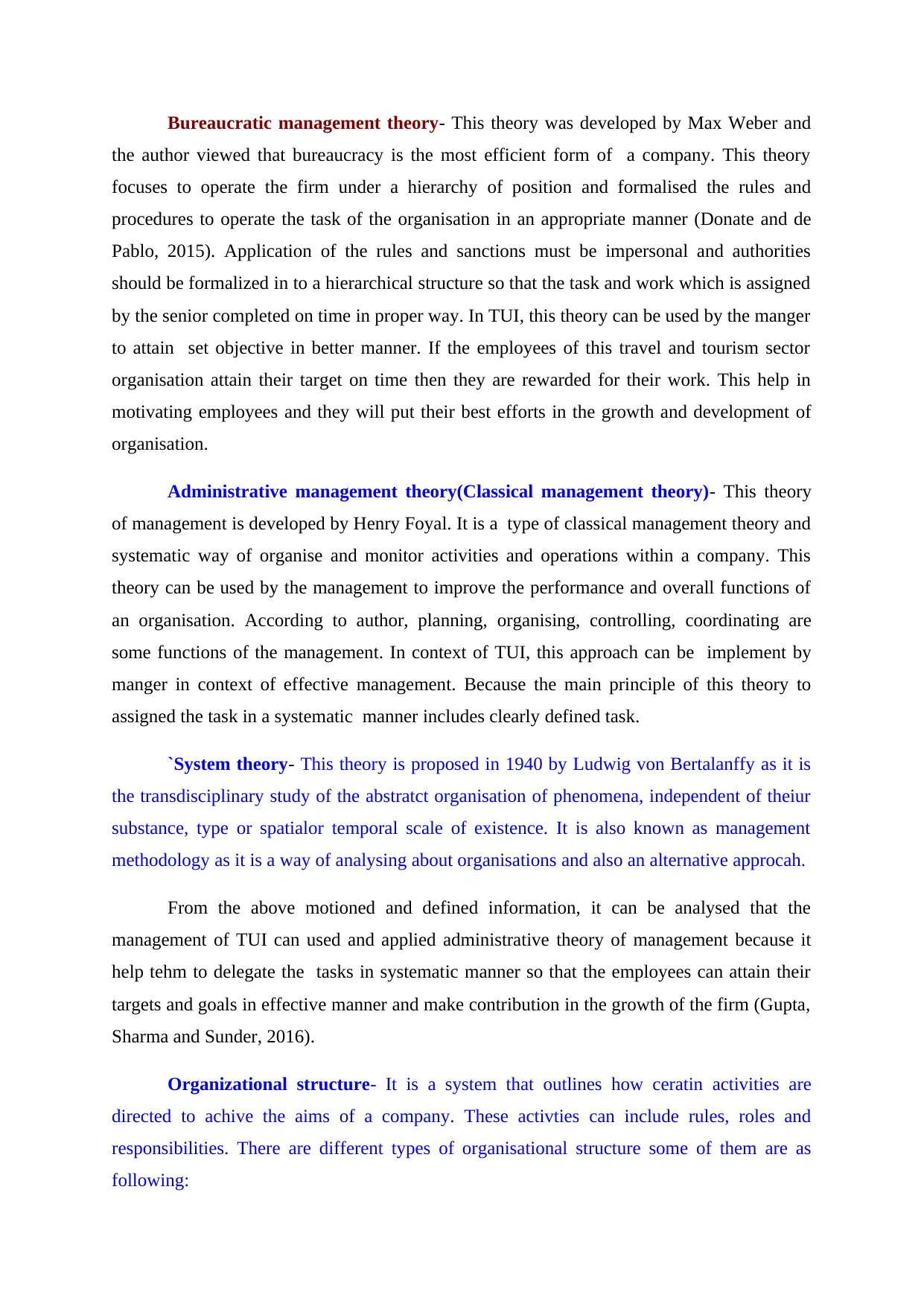
Bureaucratic management theory- This theory was developed by Max Weber and
the author viewed that bureaucracy is the most efficient form of a company. This theory
focuses to operate the firm under a hierarchy of position and formalised the rules and
procedures to operate the task of the organisation in an appropriate manner (Donate and de
Pablo, 2015). Application of the rules and sanctions must be impersonal and authorities
should be formalized in to a hierarchical structure so that the task and work which is assigned
by the senior completed on time in proper way. In TUI, this theory can be used by the manger
to attain set objective in better manner. If the employees of this travel and tourism sector
organisation attain their target on time then they are rewarded for their work. This help in
motivating employees and they will put their best efforts in the growth and development of
organisation.
Administrative management theory(Classical management theory)- This theory
of management is developed by Henry Foyal. It is a type of classical management theory and
systematic way of organise and monitor activities and operations within a company. This
theory can be used by the management to improve the performance and overall functions of
an organisation. According to author, planning, organising, controlling, coordinating are
some functions of the management. In context of TUI, this approach can be implement by
manger in context of effective management. Because the main principle of this theory to
assigned the task in a systematic manner includes clearly defined task.
`System theory- This theory is proposed in 1940 by Ludwig von Bertalanffy as it is
the transdisciplinary study of the abstratct organisation of phenomena, independent of theiur
substance, type or spatialor temporal scale of existence. It is also known as management
methodology as it is a way of analysing about organisations and also an alternative approcah.
From the above motioned and defined information, it can be analysed that the
management of TUI can used and applied administrative theory of management because it
help tehm to delegate the tasks in systematic manner so that the employees can attain their
targets and goals in effective manner and make contribution in the growth of the firm (Gupta,
Sharma and Sunder, 2016).
Organizational structure- It is a system that outlines how ceratin activities are
directed to achive the aims of a company. These activties can include rules, roles and
responsibilities. There are different types of organisational structure some of them are as
following:
the author viewed that bureaucracy is the most efficient form of a company. This theory
focuses to operate the firm under a hierarchy of position and formalised the rules and
procedures to operate the task of the organisation in an appropriate manner (Donate and de
Pablo, 2015). Application of the rules and sanctions must be impersonal and authorities
should be formalized in to a hierarchical structure so that the task and work which is assigned
by the senior completed on time in proper way. In TUI, this theory can be used by the manger
to attain set objective in better manner. If the employees of this travel and tourism sector
organisation attain their target on time then they are rewarded for their work. This help in
motivating employees and they will put their best efforts in the growth and development of
organisation.
Administrative management theory(Classical management theory)- This theory
of management is developed by Henry Foyal. It is a type of classical management theory and
systematic way of organise and monitor activities and operations within a company. This
theory can be used by the management to improve the performance and overall functions of
an organisation. According to author, planning, organising, controlling, coordinating are
some functions of the management. In context of TUI, this approach can be implement by
manger in context of effective management. Because the main principle of this theory to
assigned the task in a systematic manner includes clearly defined task.
`System theory- This theory is proposed in 1940 by Ludwig von Bertalanffy as it is
the transdisciplinary study of the abstratct organisation of phenomena, independent of theiur
substance, type or spatialor temporal scale of existence. It is also known as management
methodology as it is a way of analysing about organisations and also an alternative approcah.
From the above motioned and defined information, it can be analysed that the
management of TUI can used and applied administrative theory of management because it
help tehm to delegate the tasks in systematic manner so that the employees can attain their
targets and goals in effective manner and make contribution in the growth of the firm (Gupta,
Sharma and Sunder, 2016).
Organizational structure- It is a system that outlines how ceratin activities are
directed to achive the aims of a company. These activties can include rules, roles and
responsibilities. There are different types of organisational structure some of them are as
following:
Secure Best Marks with AI Grader
Need help grading? Try our AI Grader for instant feedback on your assignments.
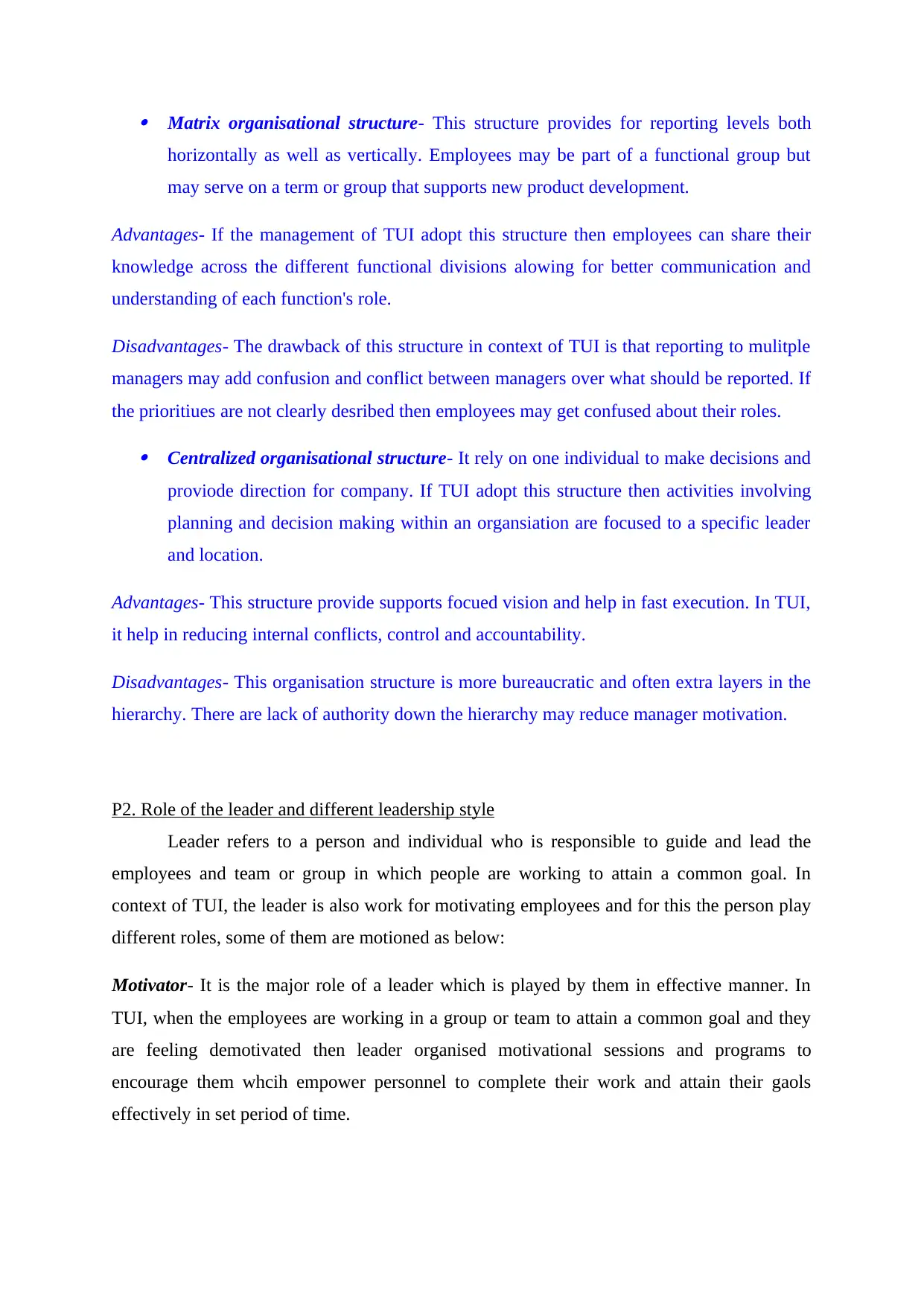
Matrix organisational structure- This structure provides for reporting levels both
horizontally as well as vertically. Employees may be part of a functional group but
may serve on a term or group that supports new product development.
Advantages- If the management of TUI adopt this structure then employees can share their
knowledge across the different functional divisions alowing for better communication and
understanding of each function's role.
Disadvantages- The drawback of this structure in context of TUI is that reporting to mulitple
managers may add confusion and conflict between managers over what should be reported. If
the prioritiues are not clearly desribed then employees may get confused about their roles.
Centralized organisational structure- It rely on one individual to make decisions and
proviode direction for company. If TUI adopt this structure then activities involving
planning and decision making within an organsiation are focused to a specific leader
and location.
Advantages- This structure provide supports focued vision and help in fast execution. In TUI,
it help in reducing internal conflicts, control and accountability.
Disadvantages- This organisation structure is more bureaucratic and often extra layers in the
hierarchy. There are lack of authority down the hierarchy may reduce manager motivation.
P2. Role of the leader and different leadership style
Leader refers to a person and individual who is responsible to guide and lead the
employees and team or group in which people are working to attain a common goal. In
context of TUI, the leader is also work for motivating employees and for this the person play
different roles, some of them are motioned as below:
Motivator- It is the major role of a leader which is played by them in effective manner. In
TUI, when the employees are working in a group or team to attain a common goal and they
are feeling demotivated then leader organised motivational sessions and programs to
encourage them whcih empower personnel to complete their work and attain their gaols
effectively in set period of time.
horizontally as well as vertically. Employees may be part of a functional group but
may serve on a term or group that supports new product development.
Advantages- If the management of TUI adopt this structure then employees can share their
knowledge across the different functional divisions alowing for better communication and
understanding of each function's role.
Disadvantages- The drawback of this structure in context of TUI is that reporting to mulitple
managers may add confusion and conflict between managers over what should be reported. If
the prioritiues are not clearly desribed then employees may get confused about their roles.
Centralized organisational structure- It rely on one individual to make decisions and
proviode direction for company. If TUI adopt this structure then activities involving
planning and decision making within an organsiation are focused to a specific leader
and location.
Advantages- This structure provide supports focued vision and help in fast execution. In TUI,
it help in reducing internal conflicts, control and accountability.
Disadvantages- This organisation structure is more bureaucratic and often extra layers in the
hierarchy. There are lack of authority down the hierarchy may reduce manager motivation.
P2. Role of the leader and different leadership style
Leader refers to a person and individual who is responsible to guide and lead the
employees and team or group in which people are working to attain a common goal. In
context of TUI, the leader is also work for motivating employees and for this the person play
different roles, some of them are motioned as below:
Motivator- It is the major role of a leader which is played by them in effective manner. In
TUI, when the employees are working in a group or team to attain a common goal and they
are feeling demotivated then leader organised motivational sessions and programs to
encourage them whcih empower personnel to complete their work and attain their gaols
effectively in set period of time.
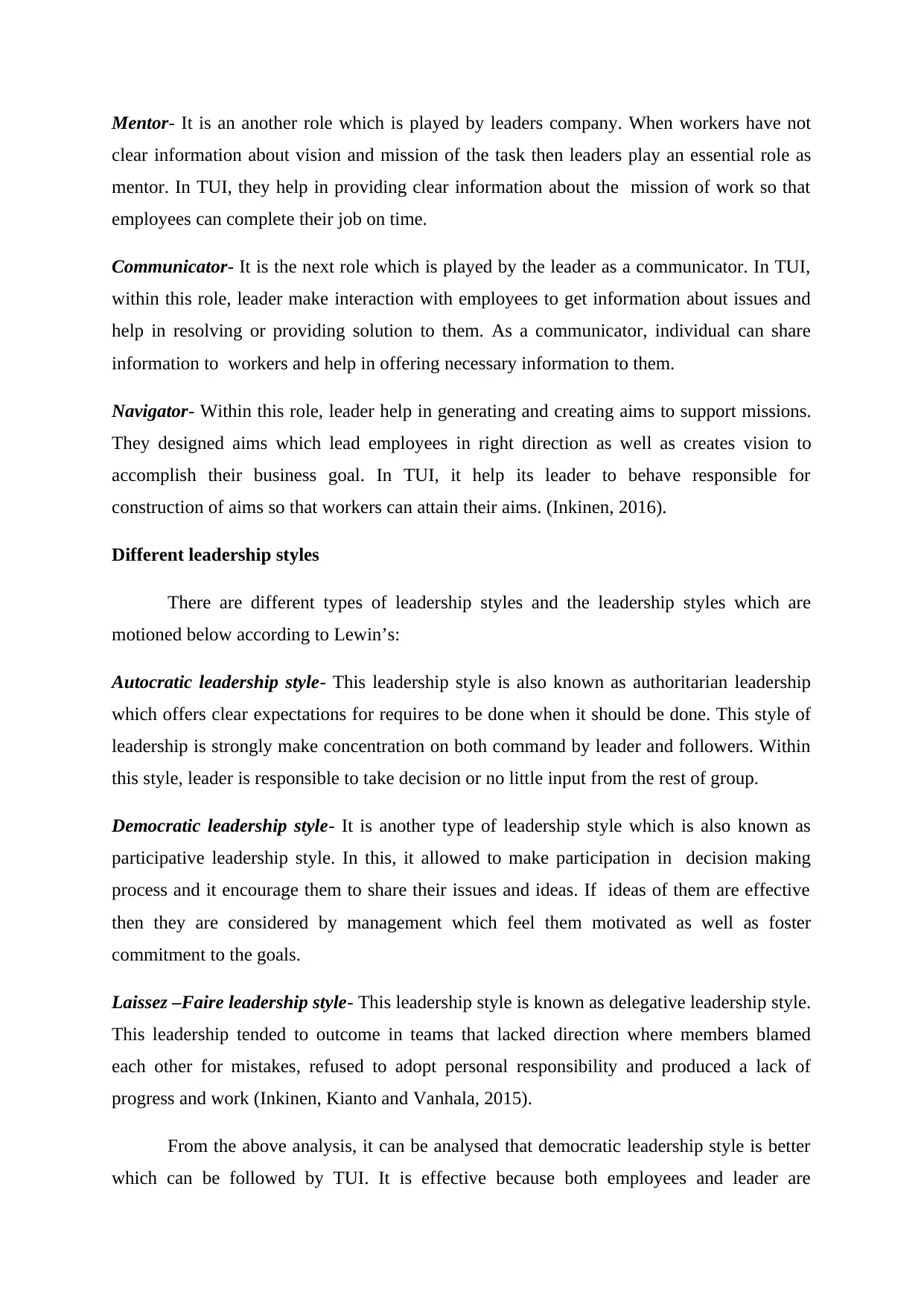
Mentor- It is an another role which is played by leaders company. When workers have not
clear information about vision and mission of the task then leaders play an essential role as
mentor. In TUI, they help in providing clear information about the mission of work so that
employees can complete their job on time.
Communicator- It is the next role which is played by the leader as a communicator. In TUI,
within this role, leader make interaction with employees to get information about issues and
help in resolving or providing solution to them. As a communicator, individual can share
information to workers and help in offering necessary information to them.
Navigator- Within this role, leader help in generating and creating aims to support missions.
They designed aims which lead employees in right direction as well as creates vision to
accomplish their business goal. In TUI, it help its leader to behave responsible for
construction of aims so that workers can attain their aims. (Inkinen, 2016).
Different leadership styles
There are different types of leadership styles and the leadership styles which are
motioned below according to Lewin’s:
Autocratic leadership style- This leadership style is also known as authoritarian leadership
which offers clear expectations for requires to be done when it should be done. This style of
leadership is strongly make concentration on both command by leader and followers. Within
this style, leader is responsible to take decision or no little input from the rest of group.
Democratic leadership style- It is another type of leadership style which is also known as
participative leadership style. In this, it allowed to make participation in decision making
process and it encourage them to share their issues and ideas. If ideas of them are effective
then they are considered by management which feel them motivated as well as foster
commitment to the goals.
Laissez –Faire leadership style- This leadership style is known as delegative leadership style.
This leadership tended to outcome in teams that lacked direction where members blamed
each other for mistakes, refused to adopt personal responsibility and produced a lack of
progress and work (Inkinen, Kianto and Vanhala, 2015).
From the above analysis, it can be analysed that democratic leadership style is better
which can be followed by TUI. It is effective because both employees and leader are
clear information about vision and mission of the task then leaders play an essential role as
mentor. In TUI, they help in providing clear information about the mission of work so that
employees can complete their job on time.
Communicator- It is the next role which is played by the leader as a communicator. In TUI,
within this role, leader make interaction with employees to get information about issues and
help in resolving or providing solution to them. As a communicator, individual can share
information to workers and help in offering necessary information to them.
Navigator- Within this role, leader help in generating and creating aims to support missions.
They designed aims which lead employees in right direction as well as creates vision to
accomplish their business goal. In TUI, it help its leader to behave responsible for
construction of aims so that workers can attain their aims. (Inkinen, 2016).
Different leadership styles
There are different types of leadership styles and the leadership styles which are
motioned below according to Lewin’s:
Autocratic leadership style- This leadership style is also known as authoritarian leadership
which offers clear expectations for requires to be done when it should be done. This style of
leadership is strongly make concentration on both command by leader and followers. Within
this style, leader is responsible to take decision or no little input from the rest of group.
Democratic leadership style- It is another type of leadership style which is also known as
participative leadership style. In this, it allowed to make participation in decision making
process and it encourage them to share their issues and ideas. If ideas of them are effective
then they are considered by management which feel them motivated as well as foster
commitment to the goals.
Laissez –Faire leadership style- This leadership style is known as delegative leadership style.
This leadership tended to outcome in teams that lacked direction where members blamed
each other for mistakes, refused to adopt personal responsibility and produced a lack of
progress and work (Inkinen, Kianto and Vanhala, 2015).
From the above analysis, it can be analysed that democratic leadership style is better
which can be followed by TUI. It is effective because both employees and leader are
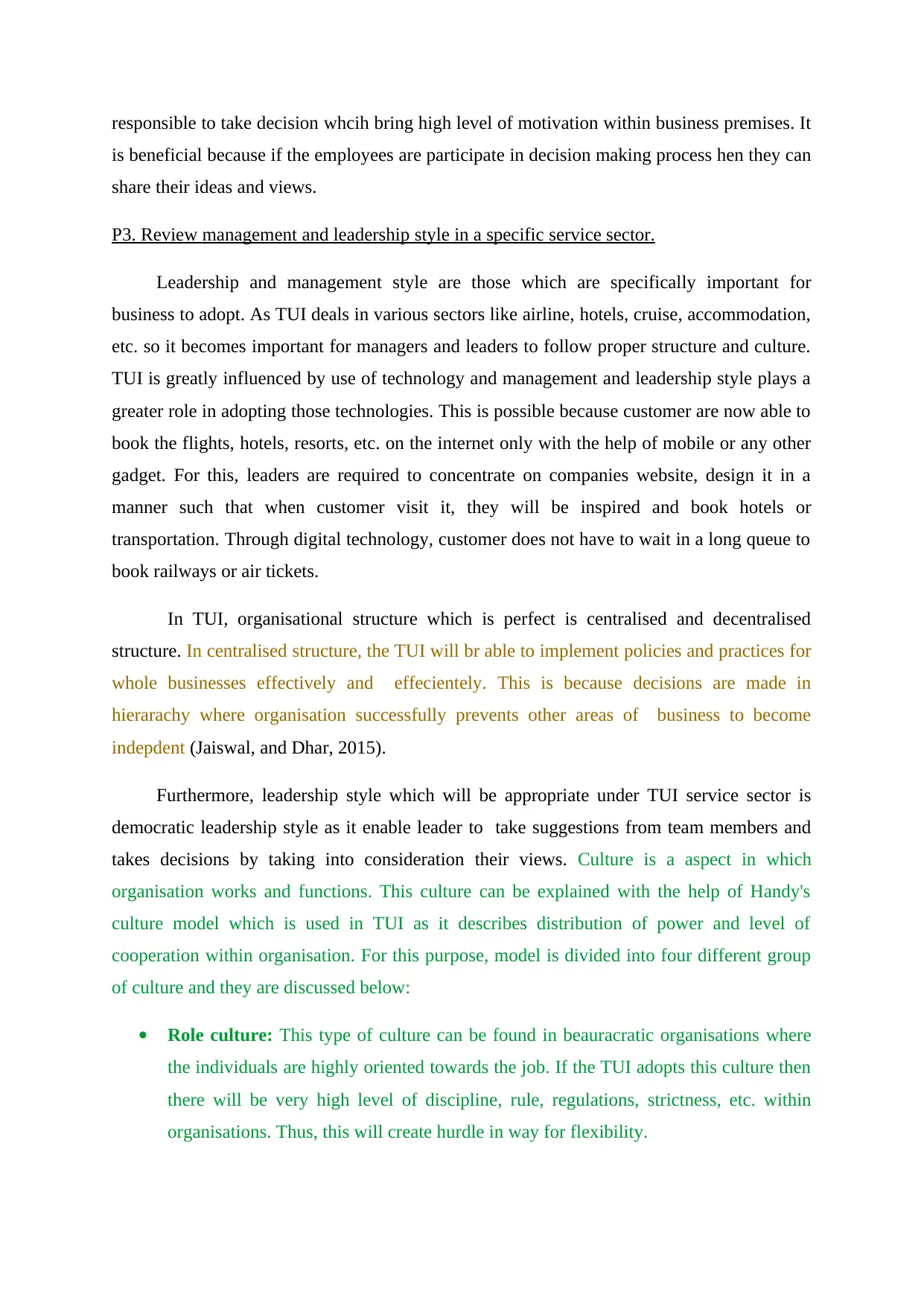
responsible to take decision whcih bring high level of motivation within business premises. It
is beneficial because if the employees are participate in decision making process hen they can
share their ideas and views.
P3. Review management and leadership style in a specific service sector.
Leadership and management style are those which are specifically important for
business to adopt. As TUI deals in various sectors like airline, hotels, cruise, accommodation,
etc. so it becomes important for managers and leaders to follow proper structure and culture.
TUI is greatly influenced by use of technology and management and leadership style plays a
greater role in adopting those technologies. This is possible because customer are now able to
book the flights, hotels, resorts, etc. on the internet only with the help of mobile or any other
gadget. For this, leaders are required to concentrate on companies website, design it in a
manner such that when customer visit it, they will be inspired and book hotels or
transportation. Through digital technology, customer does not have to wait in a long queue to
book railways or air tickets.
In TUI, organisational structure which is perfect is centralised and decentralised
structure. In centralised structure, the TUI will br able to implement policies and practices for
whole businesses effectively and effecientely. This is because decisions are made in
hierarachy where organisation successfully prevents other areas of business to become
indepdent (Jaiswal, and Dhar, 2015).
Furthermore, leadership style which will be appropriate under TUI service sector is
democratic leadership style as it enable leader to take suggestions from team members and
takes decisions by taking into consideration their views. Culture is a aspect in which
organisation works and functions. This culture can be explained with the help of Handy's
culture model which is used in TUI as it describes distribution of power and level of
cooperation within organisation. For this purpose, model is divided into four different group
of culture and they are discussed below:
Role culture: This type of culture can be found in beauracratic organisations where
the individuals are highly oriented towards the job. If the TUI adopts this culture then
there will be very high level of discipline, rule, regulations, strictness, etc. within
organisations. Thus, this will create hurdle in way for flexibility.
is beneficial because if the employees are participate in decision making process hen they can
share their ideas and views.
P3. Review management and leadership style in a specific service sector.
Leadership and management style are those which are specifically important for
business to adopt. As TUI deals in various sectors like airline, hotels, cruise, accommodation,
etc. so it becomes important for managers and leaders to follow proper structure and culture.
TUI is greatly influenced by use of technology and management and leadership style plays a
greater role in adopting those technologies. This is possible because customer are now able to
book the flights, hotels, resorts, etc. on the internet only with the help of mobile or any other
gadget. For this, leaders are required to concentrate on companies website, design it in a
manner such that when customer visit it, they will be inspired and book hotels or
transportation. Through digital technology, customer does not have to wait in a long queue to
book railways or air tickets.
In TUI, organisational structure which is perfect is centralised and decentralised
structure. In centralised structure, the TUI will br able to implement policies and practices for
whole businesses effectively and effecientely. This is because decisions are made in
hierarachy where organisation successfully prevents other areas of business to become
indepdent (Jaiswal, and Dhar, 2015).
Furthermore, leadership style which will be appropriate under TUI service sector is
democratic leadership style as it enable leader to take suggestions from team members and
takes decisions by taking into consideration their views. Culture is a aspect in which
organisation works and functions. This culture can be explained with the help of Handy's
culture model which is used in TUI as it describes distribution of power and level of
cooperation within organisation. For this purpose, model is divided into four different group
of culture and they are discussed below:
Role culture: This type of culture can be found in beauracratic organisations where
the individuals are highly oriented towards the job. If the TUI adopts this culture then
there will be very high level of discipline, rule, regulations, strictness, etc. within
organisations. Thus, this will create hurdle in way for flexibility.
Paraphrase This Document
Need a fresh take? Get an instant paraphrase of this document with our AI Paraphraser
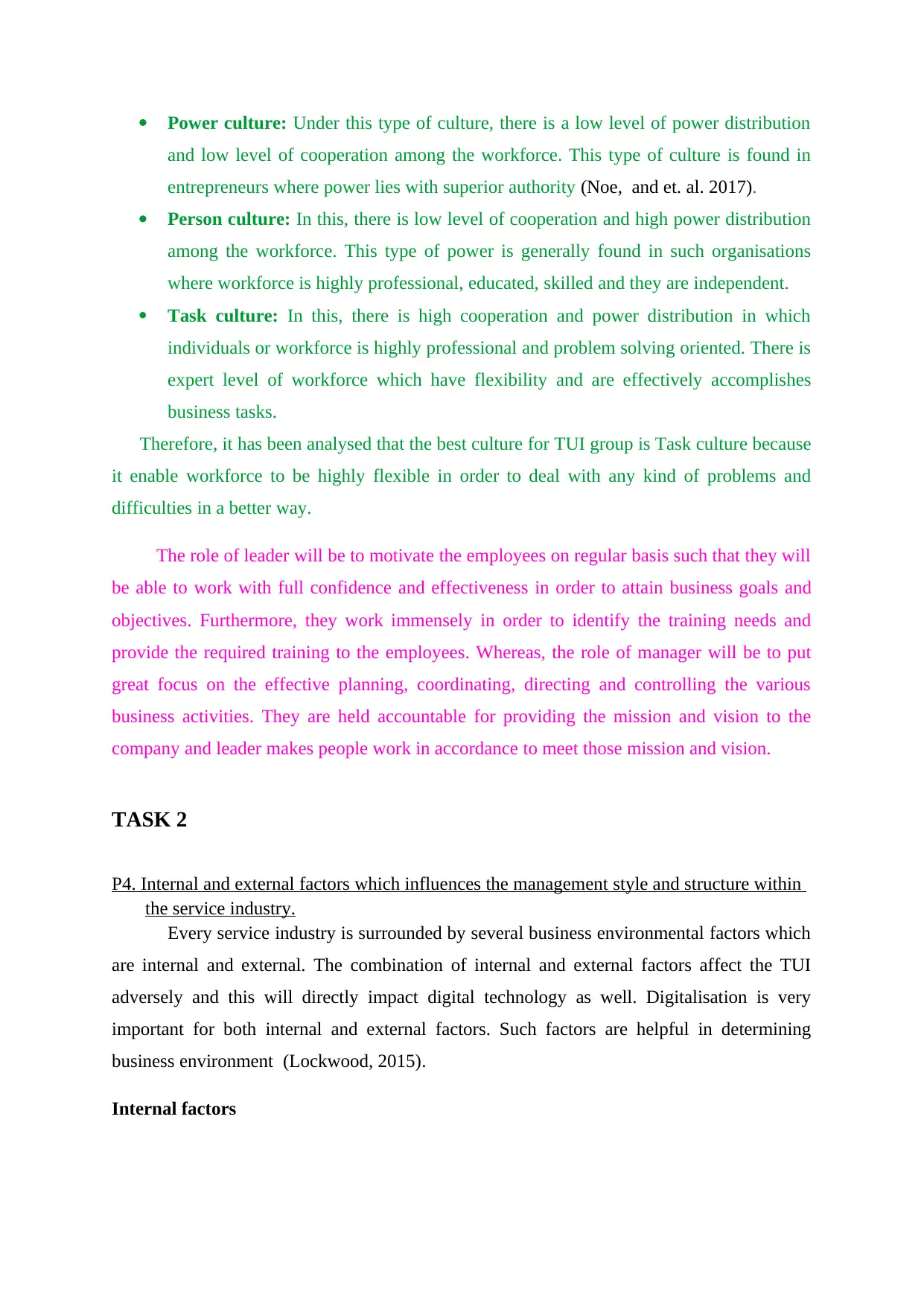
Power culture: Under this type of culture, there is a low level of power distribution
and low level of cooperation among the workforce. This type of culture is found in
entrepreneurs where power lies with superior authority (Noe, and et. al. 2017).
Person culture: In this, there is low level of cooperation and high power distribution
among the workforce. This type of power is generally found in such organisations
where workforce is highly professional, educated, skilled and they are independent.
Task culture: In this, there is high cooperation and power distribution in which
individuals or workforce is highly professional and problem solving oriented. There is
expert level of workforce which have flexibility and are effectively accomplishes
business tasks.
Therefore, it has been analysed that the best culture for TUI group is Task culture because
it enable workforce to be highly flexible in order to deal with any kind of problems and
difficulties in a better way.
The role of leader will be to motivate the employees on regular basis such that they will
be able to work with full confidence and effectiveness in order to attain business goals and
objectives. Furthermore, they work immensely in order to identify the training needs and
provide the required training to the employees. Whereas, the role of manager will be to put
great focus on the effective planning, coordinating, directing and controlling the various
business activities. They are held accountable for providing the mission and vision to the
company and leader makes people work in accordance to meet those mission and vision.
TASK 2
P4. Internal and external factors which influences the management style and structure within
the service industry.
Every service industry is surrounded by several business environmental factors which
are internal and external. The combination of internal and external factors affect the TUI
adversely and this will directly impact digital technology as well. Digitalisation is very
important for both internal and external factors. Such factors are helpful in determining
business environment (Lockwood, 2015).
Internal factors
and low level of cooperation among the workforce. This type of culture is found in
entrepreneurs where power lies with superior authority (Noe, and et. al. 2017).
Person culture: In this, there is low level of cooperation and high power distribution
among the workforce. This type of power is generally found in such organisations
where workforce is highly professional, educated, skilled and they are independent.
Task culture: In this, there is high cooperation and power distribution in which
individuals or workforce is highly professional and problem solving oriented. There is
expert level of workforce which have flexibility and are effectively accomplishes
business tasks.
Therefore, it has been analysed that the best culture for TUI group is Task culture because
it enable workforce to be highly flexible in order to deal with any kind of problems and
difficulties in a better way.
The role of leader will be to motivate the employees on regular basis such that they will
be able to work with full confidence and effectiveness in order to attain business goals and
objectives. Furthermore, they work immensely in order to identify the training needs and
provide the required training to the employees. Whereas, the role of manager will be to put
great focus on the effective planning, coordinating, directing and controlling the various
business activities. They are held accountable for providing the mission and vision to the
company and leader makes people work in accordance to meet those mission and vision.
TASK 2
P4. Internal and external factors which influences the management style and structure within
the service industry.
Every service industry is surrounded by several business environmental factors which
are internal and external. The combination of internal and external factors affect the TUI
adversely and this will directly impact digital technology as well. Digitalisation is very
important for both internal and external factors. Such factors are helpful in determining
business environment (Lockwood, 2015).
Internal factors
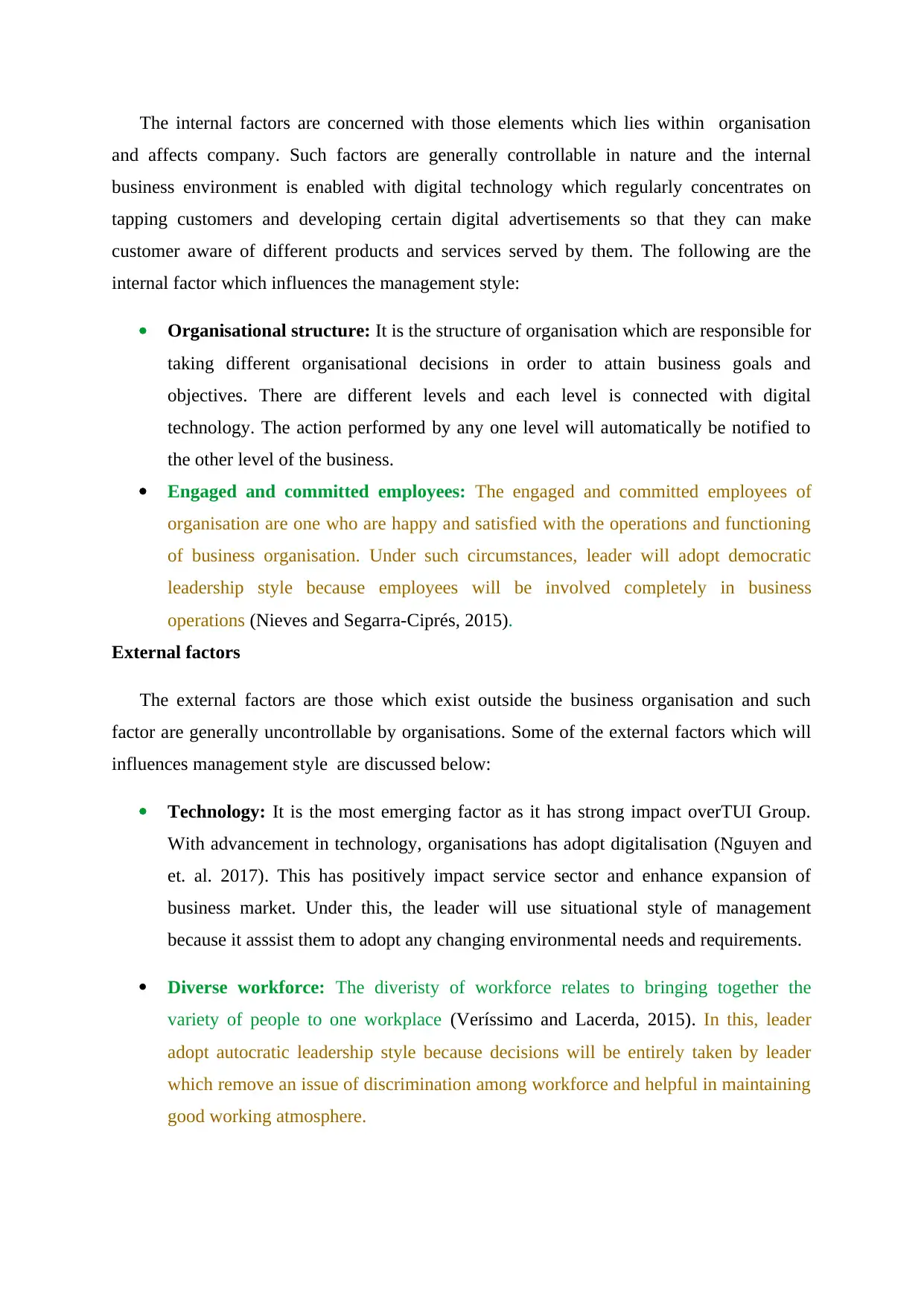
The internal factors are concerned with those elements which lies within organisation
and affects company. Such factors are generally controllable in nature and the internal
business environment is enabled with digital technology which regularly concentrates on
tapping customers and developing certain digital advertisements so that they can make
customer aware of different products and services served by them. The following are the
internal factor which influences the management style:
Organisational structure: It is the structure of organisation which are responsible for
taking different organisational decisions in order to attain business goals and
objectives. There are different levels and each level is connected with digital
technology. The action performed by any one level will automatically be notified to
the other level of the business.
Engaged and committed employees: The engaged and committed employees of
organisation are one who are happy and satisfied with the operations and functioning
of business organisation. Under such circumstances, leader will adopt democratic
leadership style because employees will be involved completely in business
operations (Nieves and Segarra-Ciprés, 2015).
External factors
The external factors are those which exist outside the business organisation and such
factor are generally uncontrollable by organisations. Some of the external factors which will
influences management style are discussed below:
Technology: It is the most emerging factor as it has strong impact overTUI Group.
With advancement in technology, organisations has adopt digitalisation (Nguyen and
et. al. 2017). This has positively impact service sector and enhance expansion of
business market. Under this, the leader will use situational style of management
because it asssist them to adopt any changing environmental needs and requirements.
Diverse workforce: The diveristy of workforce relates to bringing together the
variety of people to one workplace (Veríssimo and Lacerda, 2015). In this, leader
adopt autocratic leadership style because decisions will be entirely taken by leader
which remove an issue of discrimination among workforce and helpful in maintaining
good working atmosphere.
and affects company. Such factors are generally controllable in nature and the internal
business environment is enabled with digital technology which regularly concentrates on
tapping customers and developing certain digital advertisements so that they can make
customer aware of different products and services served by them. The following are the
internal factor which influences the management style:
Organisational structure: It is the structure of organisation which are responsible for
taking different organisational decisions in order to attain business goals and
objectives. There are different levels and each level is connected with digital
technology. The action performed by any one level will automatically be notified to
the other level of the business.
Engaged and committed employees: The engaged and committed employees of
organisation are one who are happy and satisfied with the operations and functioning
of business organisation. Under such circumstances, leader will adopt democratic
leadership style because employees will be involved completely in business
operations (Nieves and Segarra-Ciprés, 2015).
External factors
The external factors are those which exist outside the business organisation and such
factor are generally uncontrollable by organisations. Some of the external factors which will
influences management style are discussed below:
Technology: It is the most emerging factor as it has strong impact overTUI Group.
With advancement in technology, organisations has adopt digitalisation (Nguyen and
et. al. 2017). This has positively impact service sector and enhance expansion of
business market. Under this, the leader will use situational style of management
because it asssist them to adopt any changing environmental needs and requirements.
Diverse workforce: The diveristy of workforce relates to bringing together the
variety of people to one workplace (Veríssimo and Lacerda, 2015). In this, leader
adopt autocratic leadership style because decisions will be entirely taken by leader
which remove an issue of discrimination among workforce and helpful in maintaining
good working atmosphere.
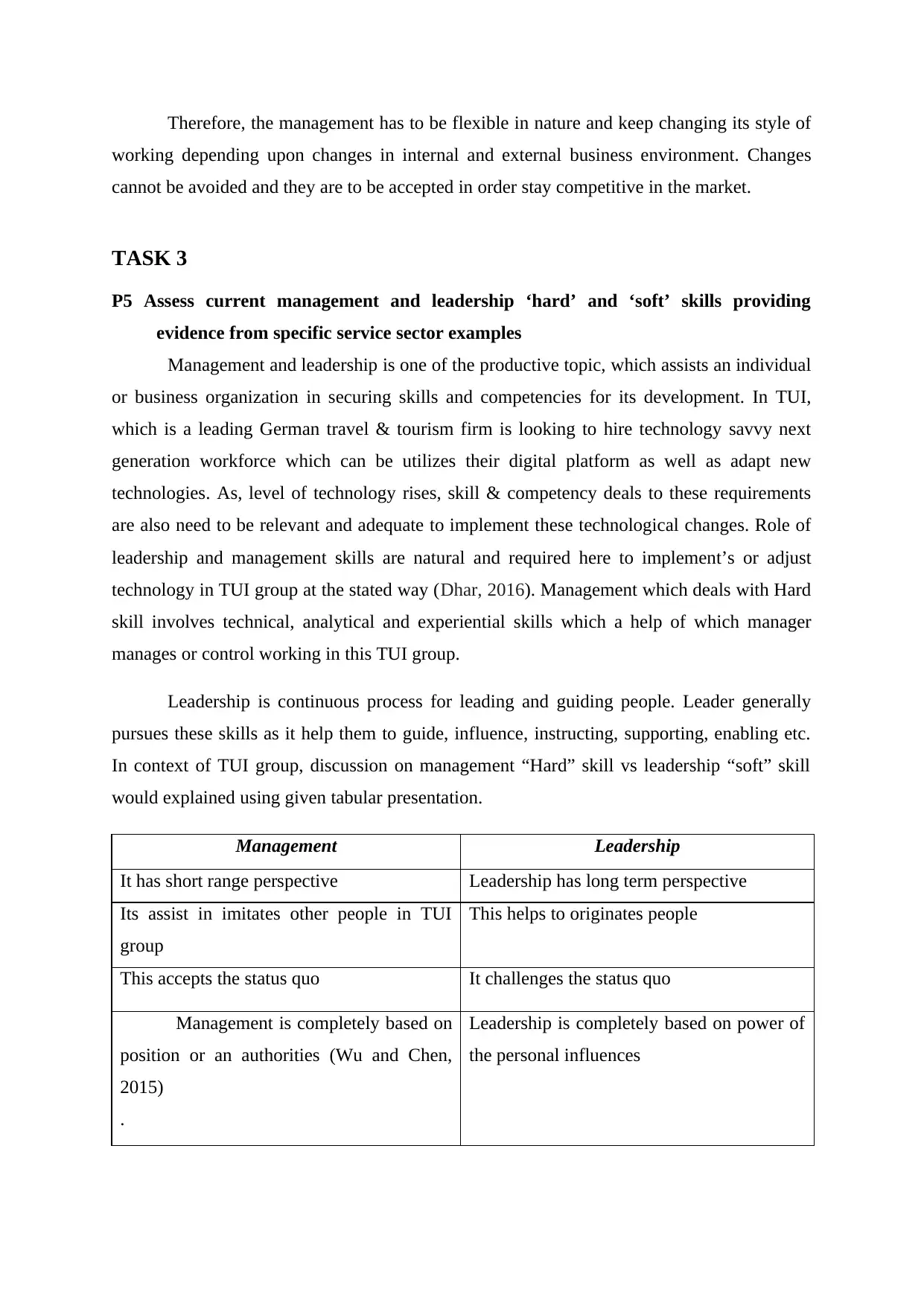
Therefore, the management has to be flexible in nature and keep changing its style of
working depending upon changes in internal and external business environment. Changes
cannot be avoided and they are to be accepted in order stay competitive in the market.
TASK 3
P5 Assess current management and leadership ‘hard’ and ‘soft’ skills providing
evidence from specific service sector examples
Management and leadership is one of the productive topic, which assists an individual
or business organization in securing skills and competencies for its development. In TUI,
which is a leading German travel & tourism firm is looking to hire technology savvy next
generation workforce which can be utilizes their digital platform as well as adapt new
technologies. As, level of technology rises, skill & competency deals to these requirements
are also need to be relevant and adequate to implement these technological changes. Role of
leadership and management skills are natural and required here to implement’s or adjust
technology in TUI group at the stated way (Dhar, 2016). Management which deals with Hard
skill involves technical, analytical and experiential skills which a help of which manager
manages or control working in this TUI group.
Leadership is continuous process for leading and guiding people. Leader generally
pursues these skills as it help them to guide, influence, instructing, supporting, enabling etc.
In context of TUI group, discussion on management “Hard” skill vs leadership “soft” skill
would explained using given tabular presentation.
Management Leadership
It has short range perspective Leadership has long term perspective
Its assist in imitates other people in TUI
group
This helps to originates people
This accepts the status quo It challenges the status quo
Management is completely based on
position or an authorities (Wu and Chen,
2015)
.
Leadership is completely based on power of
the personal influences
working depending upon changes in internal and external business environment. Changes
cannot be avoided and they are to be accepted in order stay competitive in the market.
TASK 3
P5 Assess current management and leadership ‘hard’ and ‘soft’ skills providing
evidence from specific service sector examples
Management and leadership is one of the productive topic, which assists an individual
or business organization in securing skills and competencies for its development. In TUI,
which is a leading German travel & tourism firm is looking to hire technology savvy next
generation workforce which can be utilizes their digital platform as well as adapt new
technologies. As, level of technology rises, skill & competency deals to these requirements
are also need to be relevant and adequate to implement these technological changes. Role of
leadership and management skills are natural and required here to implement’s or adjust
technology in TUI group at the stated way (Dhar, 2016). Management which deals with Hard
skill involves technical, analytical and experiential skills which a help of which manager
manages or control working in this TUI group.
Leadership is continuous process for leading and guiding people. Leader generally
pursues these skills as it help them to guide, influence, instructing, supporting, enabling etc.
In context of TUI group, discussion on management “Hard” skill vs leadership “soft” skill
would explained using given tabular presentation.
Management Leadership
It has short range perspective Leadership has long term perspective
Its assist in imitates other people in TUI
group
This helps to originates people
This accepts the status quo It challenges the status quo
Management is completely based on
position or an authorities (Wu and Chen,
2015)
.
Leadership is completely based on power of
the personal influences
Secure Best Marks with AI Grader
Need help grading? Try our AI Grader for instant feedback on your assignments.
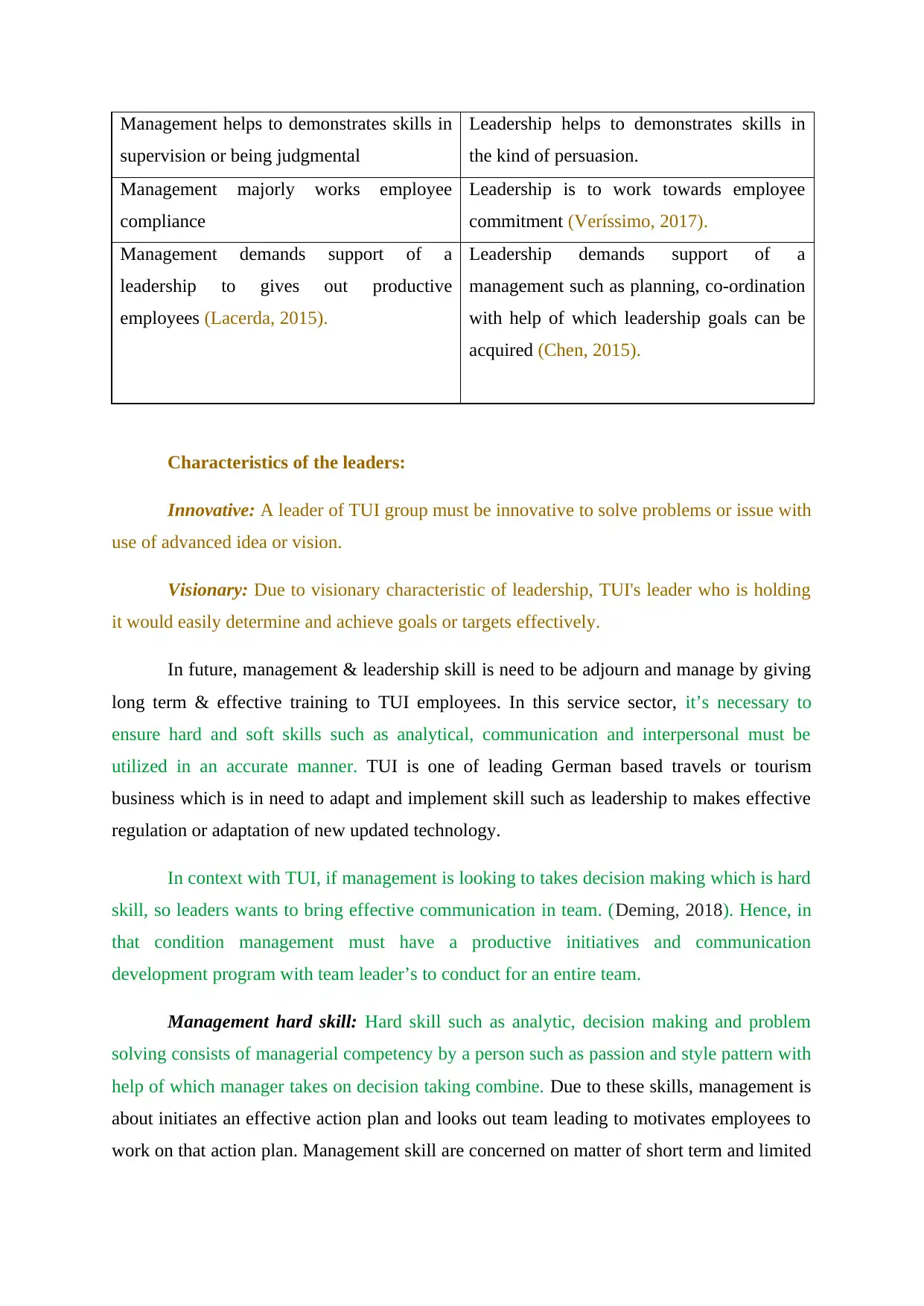
Management helps to demonstrates skills in
supervision or being judgmental
Leadership helps to demonstrates skills in
the kind of persuasion.
Management majorly works employee
compliance
Leadership is to work towards employee
commitment (Veríssimo, 2017).
Management demands support of a
leadership to gives out productive
employees (Lacerda, 2015).
Leadership demands support of a
management such as planning, co-ordination
with help of which leadership goals can be
acquired (Chen, 2015).
Characteristics of the leaders:
Innovative: A leader of TUI group must be innovative to solve problems or issue with
use of advanced idea or vision.
Visionary: Due to visionary characteristic of leadership, TUI's leader who is holding
it would easily determine and achieve goals or targets effectively.
In future, management & leadership skill is need to be adjourn and manage by giving
long term & effective training to TUI employees. In this service sector, it’s necessary to
ensure hard and soft skills such as analytical, communication and interpersonal must be
utilized in an accurate manner. TUI is one of leading German based travels or tourism
business which is in need to adapt and implement skill such as leadership to makes effective
regulation or adaptation of new updated technology.
In context with TUI, if management is looking to takes decision making which is hard
skill, so leaders wants to bring effective communication in team. (Deming, 2018). Hence, in
that condition management must have a productive initiatives and communication
development program with team leader’s to conduct for an entire team.
Management hard skill: Hard skill such as analytic, decision making and problem
solving consists of managerial competency by a person such as passion and style pattern with
help of which manager takes on decision taking combine. Due to these skills, management is
about initiates an effective action plan and looks out team leading to motivates employees to
work on that action plan. Management skill are concerned on matter of short term and limited
supervision or being judgmental
Leadership helps to demonstrates skills in
the kind of persuasion.
Management majorly works employee
compliance
Leadership is to work towards employee
commitment (Veríssimo, 2017).
Management demands support of a
leadership to gives out productive
employees (Lacerda, 2015).
Leadership demands support of a
management such as planning, co-ordination
with help of which leadership goals can be
acquired (Chen, 2015).
Characteristics of the leaders:
Innovative: A leader of TUI group must be innovative to solve problems or issue with
use of advanced idea or vision.
Visionary: Due to visionary characteristic of leadership, TUI's leader who is holding
it would easily determine and achieve goals or targets effectively.
In future, management & leadership skill is need to be adjourn and manage by giving
long term & effective training to TUI employees. In this service sector, it’s necessary to
ensure hard and soft skills such as analytical, communication and interpersonal must be
utilized in an accurate manner. TUI is one of leading German based travels or tourism
business which is in need to adapt and implement skill such as leadership to makes effective
regulation or adaptation of new updated technology.
In context with TUI, if management is looking to takes decision making which is hard
skill, so leaders wants to bring effective communication in team. (Deming, 2018). Hence, in
that condition management must have a productive initiatives and communication
development program with team leader’s to conduct for an entire team.
Management hard skill: Hard skill such as analytic, decision making and problem
solving consists of managerial competency by a person such as passion and style pattern with
help of which manager takes on decision taking combine. Due to these skills, management is
about initiates an effective action plan and looks out team leading to motivates employees to
work on that action plan. Management skill are concerned on matter of short term and limited
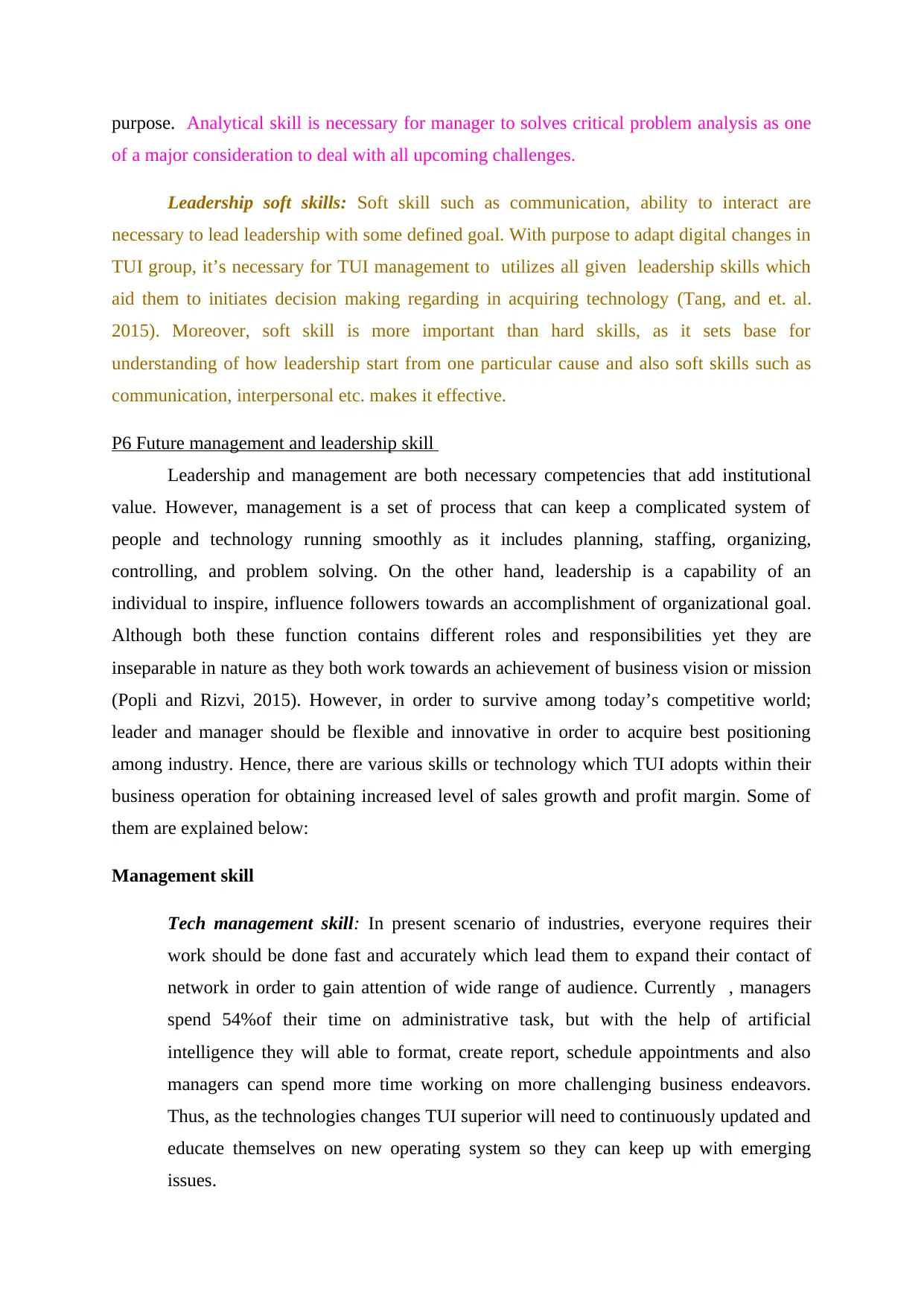
purpose. Analytical skill is necessary for manager to solves critical problem analysis as one
of a major consideration to deal with all upcoming challenges.
Leadership soft skills: Soft skill such as communication, ability to interact are
necessary to lead leadership with some defined goal. With purpose to adapt digital changes in
TUI group, it’s necessary for TUI management to utilizes all given leadership skills which
aid them to initiates decision making regarding in acquiring technology (Tang, and et. al.
2015). Moreover, soft skill is more important than hard skills, as it sets base for
understanding of how leadership start from one particular cause and also soft skills such as
communication, interpersonal etc. makes it effective.
P6 Future management and leadership skill
Leadership and management are both necessary competencies that add institutional
value. However, management is a set of process that can keep a complicated system of
people and technology running smoothly as it includes planning, staffing, organizing,
controlling, and problem solving. On the other hand, leadership is a capability of an
individual to inspire, influence followers towards an accomplishment of organizational goal.
Although both these function contains different roles and responsibilities yet they are
inseparable in nature as they both work towards an achievement of business vision or mission
(Popli and Rizvi, 2015). However, in order to survive among today’s competitive world;
leader and manager should be flexible and innovative in order to acquire best positioning
among industry. Hence, there are various skills or technology which TUI adopts within their
business operation for obtaining increased level of sales growth and profit margin. Some of
them are explained below:
Management skill
Tech management skill: In present scenario of industries, everyone requires their
work should be done fast and accurately which lead them to expand their contact of
network in order to gain attention of wide range of audience. Currently , managers
spend 54%of their time on administrative task, but with the help of artificial
intelligence they will able to format, create report, schedule appointments and also
managers can spend more time working on more challenging business endeavors.
Thus, as the technologies changes TUI superior will need to continuously updated and
educate themselves on new operating system so they can keep up with emerging
issues.
of a major consideration to deal with all upcoming challenges.
Leadership soft skills: Soft skill such as communication, ability to interact are
necessary to lead leadership with some defined goal. With purpose to adapt digital changes in
TUI group, it’s necessary for TUI management to utilizes all given leadership skills which
aid them to initiates decision making regarding in acquiring technology (Tang, and et. al.
2015). Moreover, soft skill is more important than hard skills, as it sets base for
understanding of how leadership start from one particular cause and also soft skills such as
communication, interpersonal etc. makes it effective.
P6 Future management and leadership skill
Leadership and management are both necessary competencies that add institutional
value. However, management is a set of process that can keep a complicated system of
people and technology running smoothly as it includes planning, staffing, organizing,
controlling, and problem solving. On the other hand, leadership is a capability of an
individual to inspire, influence followers towards an accomplishment of organizational goal.
Although both these function contains different roles and responsibilities yet they are
inseparable in nature as they both work towards an achievement of business vision or mission
(Popli and Rizvi, 2015). However, in order to survive among today’s competitive world;
leader and manager should be flexible and innovative in order to acquire best positioning
among industry. Hence, there are various skills or technology which TUI adopts within their
business operation for obtaining increased level of sales growth and profit margin. Some of
them are explained below:
Management skill
Tech management skill: In present scenario of industries, everyone requires their
work should be done fast and accurately which lead them to expand their contact of
network in order to gain attention of wide range of audience. Currently , managers
spend 54%of their time on administrative task, but with the help of artificial
intelligence they will able to format, create report, schedule appointments and also
managers can spend more time working on more challenging business endeavors.
Thus, as the technologies changes TUI superior will need to continuously updated and
educate themselves on new operating system so they can keep up with emerging
issues.
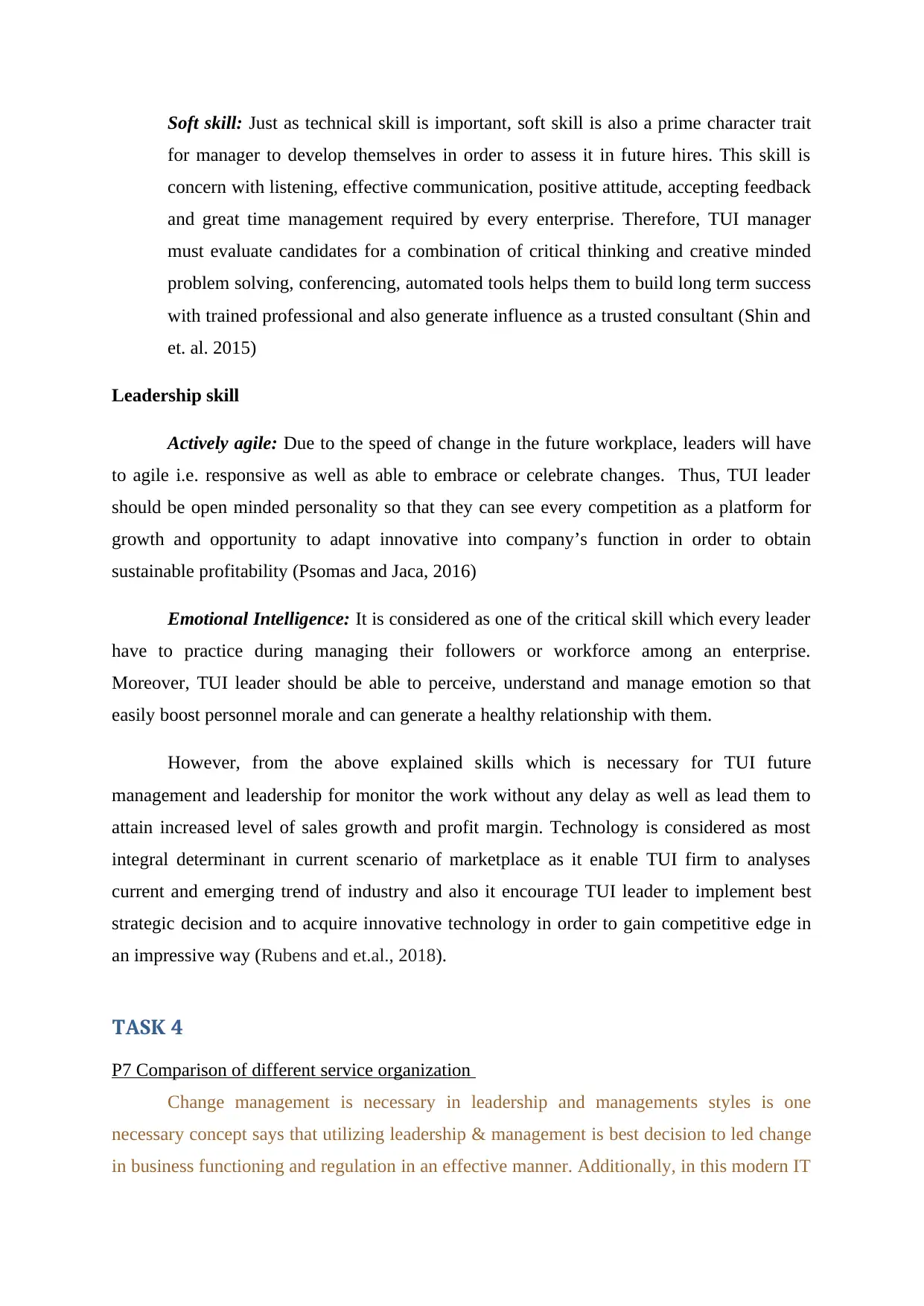
Soft skill: Just as technical skill is important, soft skill is also a prime character trait
for manager to develop themselves in order to assess it in future hires. This skill is
concern with listening, effective communication, positive attitude, accepting feedback
and great time management required by every enterprise. Therefore, TUI manager
must evaluate candidates for a combination of critical thinking and creative minded
problem solving, conferencing, automated tools helps them to build long term success
with trained professional and also generate influence as a trusted consultant (Shin and
et. al. 2015)
Leadership skill
Actively agile: Due to the speed of change in the future workplace, leaders will have
to agile i.e. responsive as well as able to embrace or celebrate changes. Thus, TUI leader
should be open minded personality so that they can see every competition as a platform for
growth and opportunity to adapt innovative into company’s function in order to obtain
sustainable profitability (Psomas and Jaca, 2016)
Emotional Intelligence: It is considered as one of the critical skill which every leader
have to practice during managing their followers or workforce among an enterprise.
Moreover, TUI leader should be able to perceive, understand and manage emotion so that
easily boost personnel morale and can generate a healthy relationship with them.
However, from the above explained skills which is necessary for TUI future
management and leadership for monitor the work without any delay as well as lead them to
attain increased level of sales growth and profit margin. Technology is considered as most
integral determinant in current scenario of marketplace as it enable TUI firm to analyses
current and emerging trend of industry and also it encourage TUI leader to implement best
strategic decision and to acquire innovative technology in order to gain competitive edge in
an impressive way (Rubens and et.al., 2018).
TASK 4
P7 Comparison of different service organization
Change management is necessary in leadership and managements styles is one
necessary concept says that utilizing leadership & management is best decision to led change
in business functioning and regulation in an effective manner. Additionally, in this modern IT
for manager to develop themselves in order to assess it in future hires. This skill is
concern with listening, effective communication, positive attitude, accepting feedback
and great time management required by every enterprise. Therefore, TUI manager
must evaluate candidates for a combination of critical thinking and creative minded
problem solving, conferencing, automated tools helps them to build long term success
with trained professional and also generate influence as a trusted consultant (Shin and
et. al. 2015)
Leadership skill
Actively agile: Due to the speed of change in the future workplace, leaders will have
to agile i.e. responsive as well as able to embrace or celebrate changes. Thus, TUI leader
should be open minded personality so that they can see every competition as a platform for
growth and opportunity to adapt innovative into company’s function in order to obtain
sustainable profitability (Psomas and Jaca, 2016)
Emotional Intelligence: It is considered as one of the critical skill which every leader
have to practice during managing their followers or workforce among an enterprise.
Moreover, TUI leader should be able to perceive, understand and manage emotion so that
easily boost personnel morale and can generate a healthy relationship with them.
However, from the above explained skills which is necessary for TUI future
management and leadership for monitor the work without any delay as well as lead them to
attain increased level of sales growth and profit margin. Technology is considered as most
integral determinant in current scenario of marketplace as it enable TUI firm to analyses
current and emerging trend of industry and also it encourage TUI leader to implement best
strategic decision and to acquire innovative technology in order to gain competitive edge in
an impressive way (Rubens and et.al., 2018).
TASK 4
P7 Comparison of different service organization
Change management is necessary in leadership and managements styles is one
necessary concept says that utilizing leadership & management is best decision to led change
in business functioning and regulation in an effective manner. Additionally, in this modern IT
Paraphrase This Document
Need a fresh take? Get an instant paraphrase of this document with our AI Paraphraser
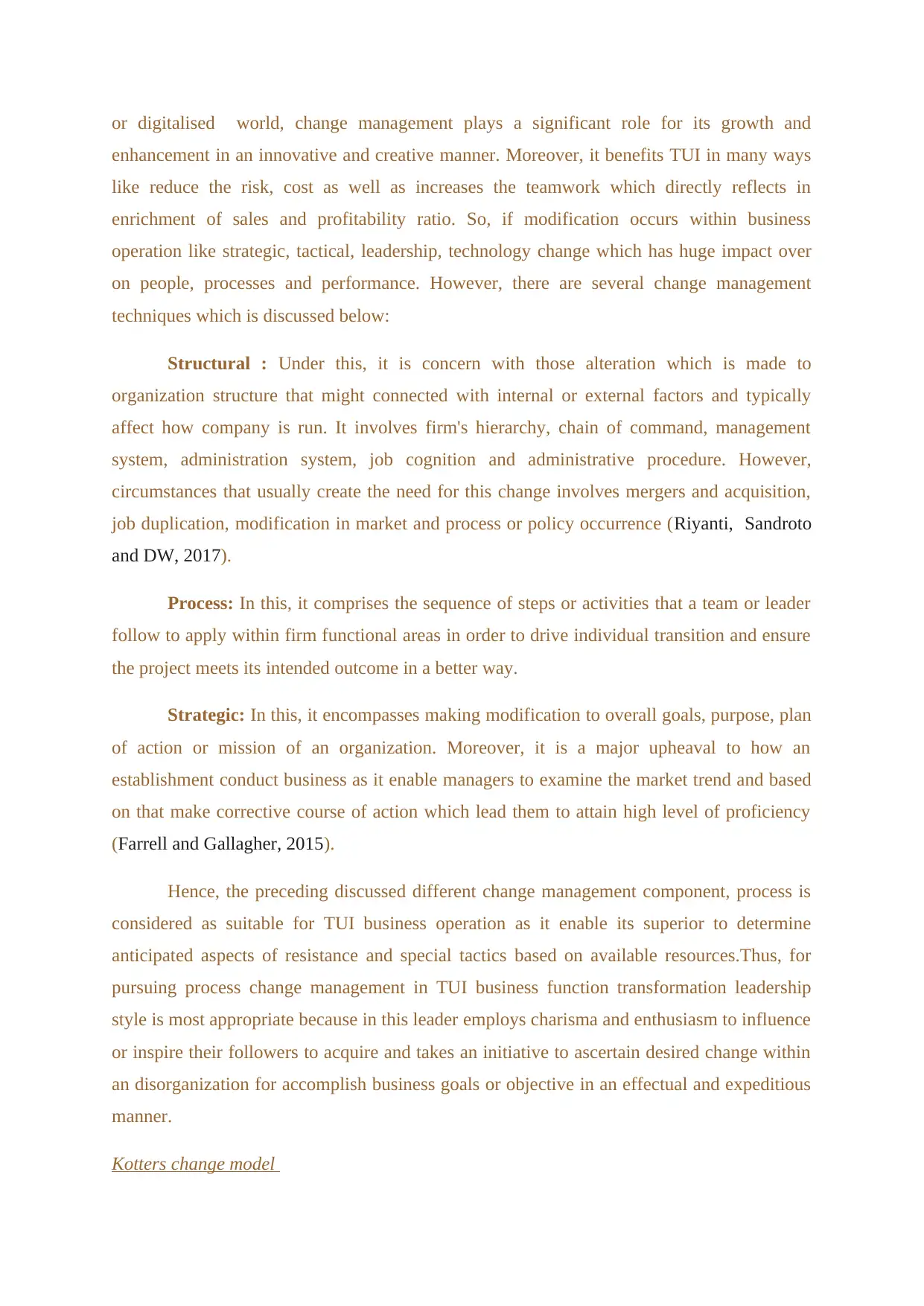
or digitalised world, change management plays a significant role for its growth and
enhancement in an innovative and creative manner. Moreover, it benefits TUI in many ways
like reduce the risk, cost as well as increases the teamwork which directly reflects in
enrichment of sales and profitability ratio. So, if modification occurs within business
operation like strategic, tactical, leadership, technology change which has huge impact over
on people, processes and performance. However, there are several change management
techniques which is discussed below:
Structural : Under this, it is concern with those alteration which is made to
organization structure that might connected with internal or external factors and typically
affect how company is run. It involves firm's hierarchy, chain of command, management
system, administration system, job cognition and administrative procedure. However,
circumstances that usually create the need for this change involves mergers and acquisition,
job duplication, modification in market and process or policy occurrence (Riyanti, Sandroto
and DW, 2017).
Process: In this, it comprises the sequence of steps or activities that a team or leader
follow to apply within firm functional areas in order to drive individual transition and ensure
the project meets its intended outcome in a better way.
Strategic: In this, it encompasses making modification to overall goals, purpose, plan
of action or mission of an organization. Moreover, it is a major upheaval to how an
establishment conduct business as it enable managers to examine the market trend and based
on that make corrective course of action which lead them to attain high level of proficiency
(Farrell and Gallagher, 2015).
Hence, the preceding discussed different change management component, process is
considered as suitable for TUI business operation as it enable its superior to determine
anticipated aspects of resistance and special tactics based on available resources.Thus, for
pursuing process change management in TUI business function transformation leadership
style is most appropriate because in this leader employs charisma and enthusiasm to influence
or inspire their followers to acquire and takes an initiative to ascertain desired change within
an disorganization for accomplish business goals or objective in an effectual and expeditious
manner.
Kotters change model
enhancement in an innovative and creative manner. Moreover, it benefits TUI in many ways
like reduce the risk, cost as well as increases the teamwork which directly reflects in
enrichment of sales and profitability ratio. So, if modification occurs within business
operation like strategic, tactical, leadership, technology change which has huge impact over
on people, processes and performance. However, there are several change management
techniques which is discussed below:
Structural : Under this, it is concern with those alteration which is made to
organization structure that might connected with internal or external factors and typically
affect how company is run. It involves firm's hierarchy, chain of command, management
system, administration system, job cognition and administrative procedure. However,
circumstances that usually create the need for this change involves mergers and acquisition,
job duplication, modification in market and process or policy occurrence (Riyanti, Sandroto
and DW, 2017).
Process: In this, it comprises the sequence of steps or activities that a team or leader
follow to apply within firm functional areas in order to drive individual transition and ensure
the project meets its intended outcome in a better way.
Strategic: In this, it encompasses making modification to overall goals, purpose, plan
of action or mission of an organization. Moreover, it is a major upheaval to how an
establishment conduct business as it enable managers to examine the market trend and based
on that make corrective course of action which lead them to attain high level of proficiency
(Farrell and Gallagher, 2015).
Hence, the preceding discussed different change management component, process is
considered as suitable for TUI business operation as it enable its superior to determine
anticipated aspects of resistance and special tactics based on available resources.Thus, for
pursuing process change management in TUI business function transformation leadership
style is most appropriate because in this leader employs charisma and enthusiasm to influence
or inspire their followers to acquire and takes an initiative to ascertain desired change within
an disorganization for accomplish business goals or objective in an effectual and expeditious
manner.
Kotters change model
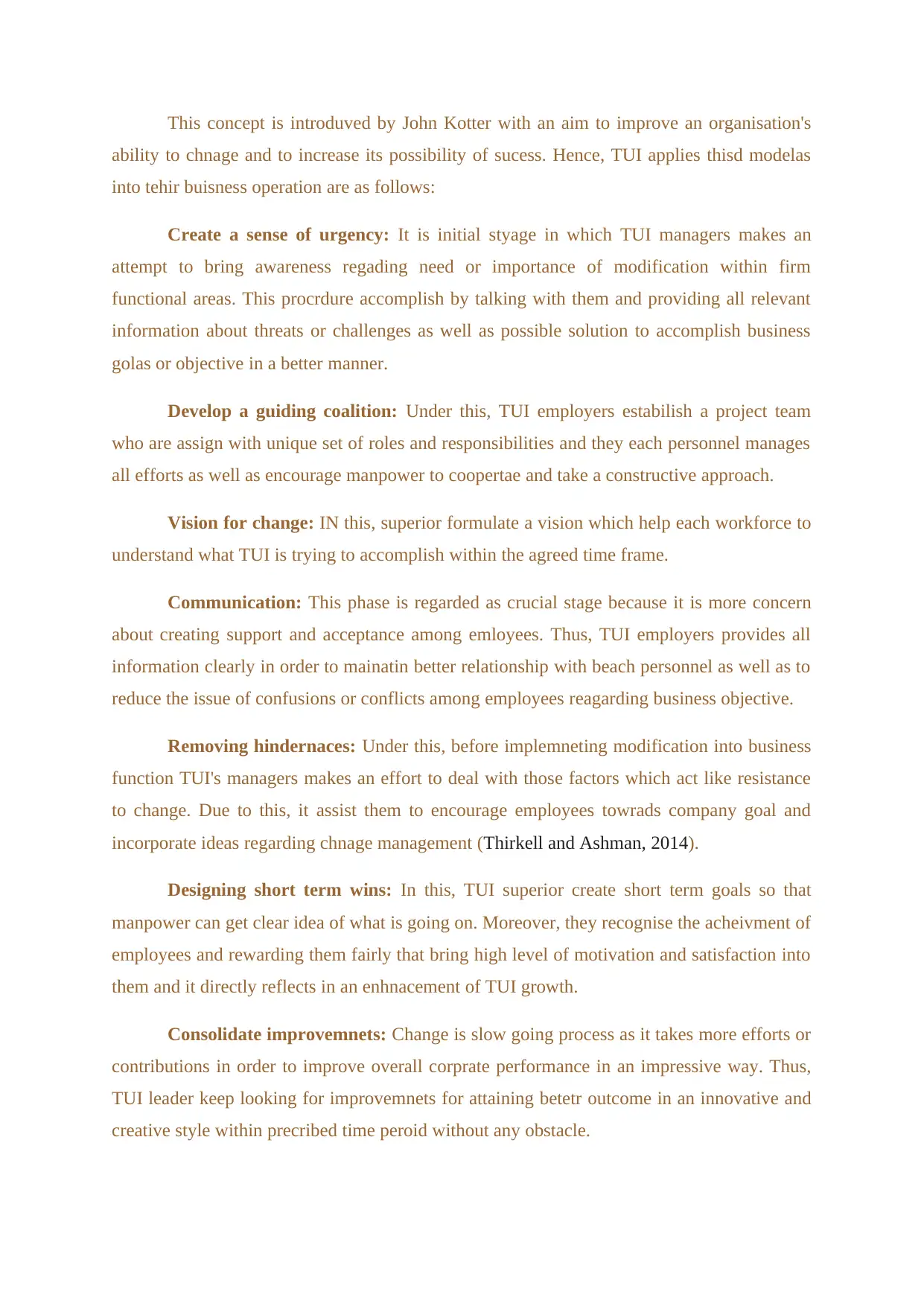
This concept is introduved by John Kotter with an aim to improve an organisation's
ability to chnage and to increase its possibility of sucess. Hence, TUI applies thisd modelas
into tehir buisness operation are as follows:
Create a sense of urgency: It is initial styage in which TUI managers makes an
attempt to bring awareness regading need or importance of modification within firm
functional areas. This procrdure accomplish by talking with them and providing all relevant
information about threats or challenges as well as possible solution to accomplish business
golas or objective in a better manner.
Develop a guiding coalition: Under this, TUI employers estabilish a project team
who are assign with unique set of roles and responsibilities and they each personnel manages
all efforts as well as encourage manpower to coopertae and take a constructive approach.
Vision for change: IN this, superior formulate a vision which help each workforce to
understand what TUI is trying to accomplish within the agreed time frame.
Communication: This phase is regarded as crucial stage because it is more concern
about creating support and acceptance among emloyees. Thus, TUI employers provides all
information clearly in order to mainatin better relationship with beach personnel as well as to
reduce the issue of confusions or conflicts among employees reagarding business objective.
Removing hindernaces: Under this, before implemneting modification into business
function TUI's managers makes an effort to deal with those factors which act like resistance
to change. Due to this, it assist them to encourage employees towrads company goal and
incorporate ideas regarding chnage management (Thirkell and Ashman, 2014).
Designing short term wins: In this, TUI superior create short term goals so that
manpower can get clear idea of what is going on. Moreover, they recognise the acheivment of
employees and rewarding them fairly that bring high level of motivation and satisfaction into
them and it directly reflects in an enhnacement of TUI growth.
Consolidate improvemnets: Change is slow going process as it takes more efforts or
contributions in order to improve overall corprate performance in an impressive way. Thus,
TUI leader keep looking for improvemnets for attaining betetr outcome in an innovative and
creative style within precribed time peroid without any obstacle.
ability to chnage and to increase its possibility of sucess. Hence, TUI applies thisd modelas
into tehir buisness operation are as follows:
Create a sense of urgency: It is initial styage in which TUI managers makes an
attempt to bring awareness regading need or importance of modification within firm
functional areas. This procrdure accomplish by talking with them and providing all relevant
information about threats or challenges as well as possible solution to accomplish business
golas or objective in a better manner.
Develop a guiding coalition: Under this, TUI employers estabilish a project team
who are assign with unique set of roles and responsibilities and they each personnel manages
all efforts as well as encourage manpower to coopertae and take a constructive approach.
Vision for change: IN this, superior formulate a vision which help each workforce to
understand what TUI is trying to accomplish within the agreed time frame.
Communication: This phase is regarded as crucial stage because it is more concern
about creating support and acceptance among emloyees. Thus, TUI employers provides all
information clearly in order to mainatin better relationship with beach personnel as well as to
reduce the issue of confusions or conflicts among employees reagarding business objective.
Removing hindernaces: Under this, before implemneting modification into business
function TUI's managers makes an effort to deal with those factors which act like resistance
to change. Due to this, it assist them to encourage employees towrads company goal and
incorporate ideas regarding chnage management (Thirkell and Ashman, 2014).
Designing short term wins: In this, TUI superior create short term goals so that
manpower can get clear idea of what is going on. Moreover, they recognise the acheivment of
employees and rewarding them fairly that bring high level of motivation and satisfaction into
them and it directly reflects in an enhnacement of TUI growth.
Consolidate improvemnets: Change is slow going process as it takes more efforts or
contributions in order to improve overall corprate performance in an impressive way. Thus,
TUI leader keep looking for improvemnets for attaining betetr outcome in an innovative and
creative style within precribed time peroid without any obstacle.
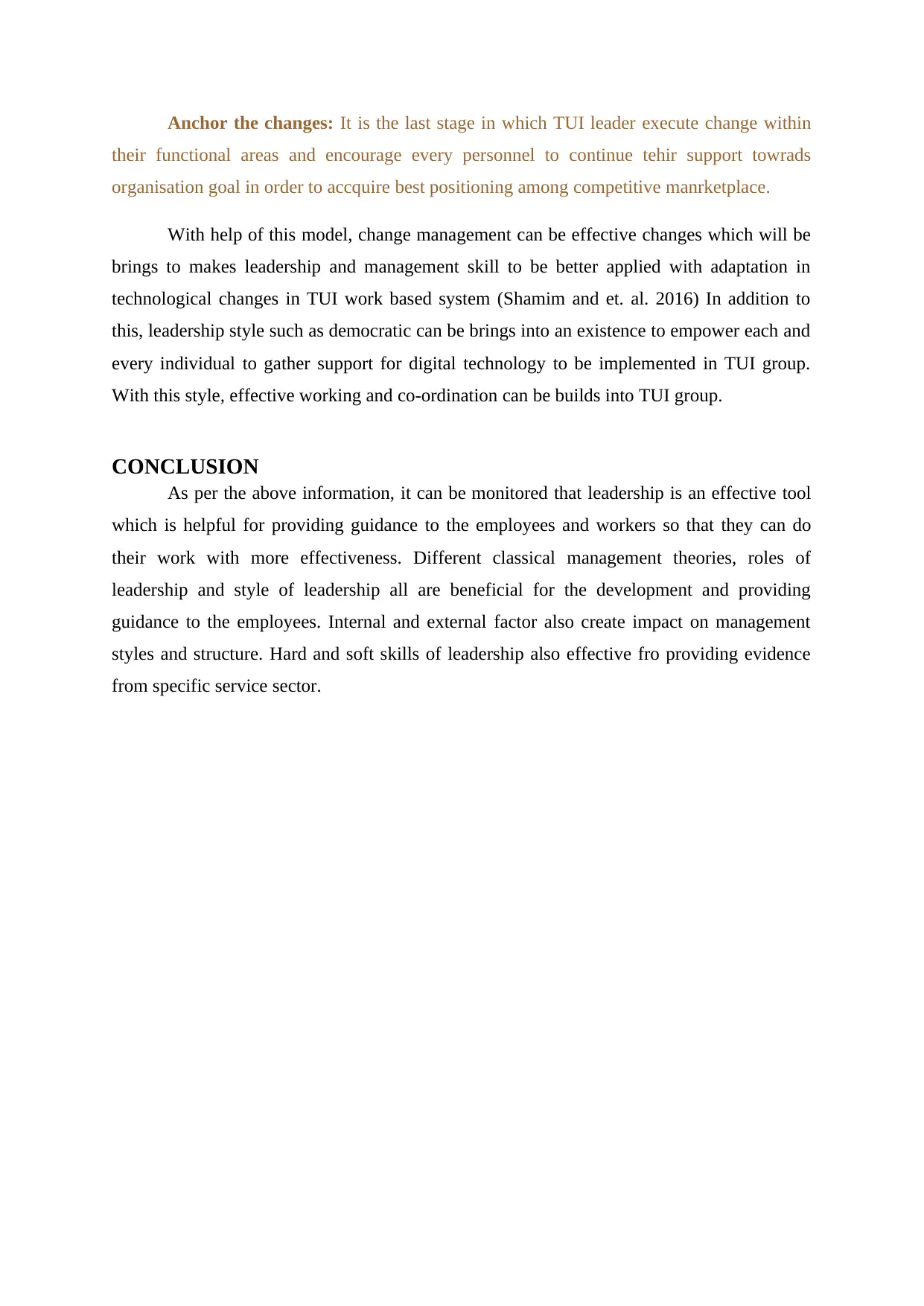
Anchor the changes: It is the last stage in which TUI leader execute change within
their functional areas and encourage every personnel to continue tehir support towrads
organisation goal in order to accquire best positioning among competitive manrketplace.
With help of this model, change management can be effective changes which will be
brings to makes leadership and management skill to be better applied with adaptation in
technological changes in TUI work based system (Shamim and et. al. 2016) In addition to
this, leadership style such as democratic can be brings into an existence to empower each and
every individual to gather support for digital technology to be implemented in TUI group.
With this style, effective working and co-ordination can be builds into TUI group.
CONCLUSION
As per the above information, it can be monitored that leadership is an effective tool
which is helpful for providing guidance to the employees and workers so that they can do
their work with more effectiveness. Different classical management theories, roles of
leadership and style of leadership all are beneficial for the development and providing
guidance to the employees. Internal and external factor also create impact on management
styles and structure. Hard and soft skills of leadership also effective fro providing evidence
from specific service sector.
their functional areas and encourage every personnel to continue tehir support towrads
organisation goal in order to accquire best positioning among competitive manrketplace.
With help of this model, change management can be effective changes which will be
brings to makes leadership and management skill to be better applied with adaptation in
technological changes in TUI work based system (Shamim and et. al. 2016) In addition to
this, leadership style such as democratic can be brings into an existence to empower each and
every individual to gather support for digital technology to be implemented in TUI group.
With this style, effective working and co-ordination can be builds into TUI group.
CONCLUSION
As per the above information, it can be monitored that leadership is an effective tool
which is helpful for providing guidance to the employees and workers so that they can do
their work with more effectiveness. Different classical management theories, roles of
leadership and style of leadership all are beneficial for the development and providing
guidance to the employees. Internal and external factor also create impact on management
styles and structure. Hard and soft skills of leadership also effective fro providing evidence
from specific service sector.
Secure Best Marks with AI Grader
Need help grading? Try our AI Grader for instant feedback on your assignments.
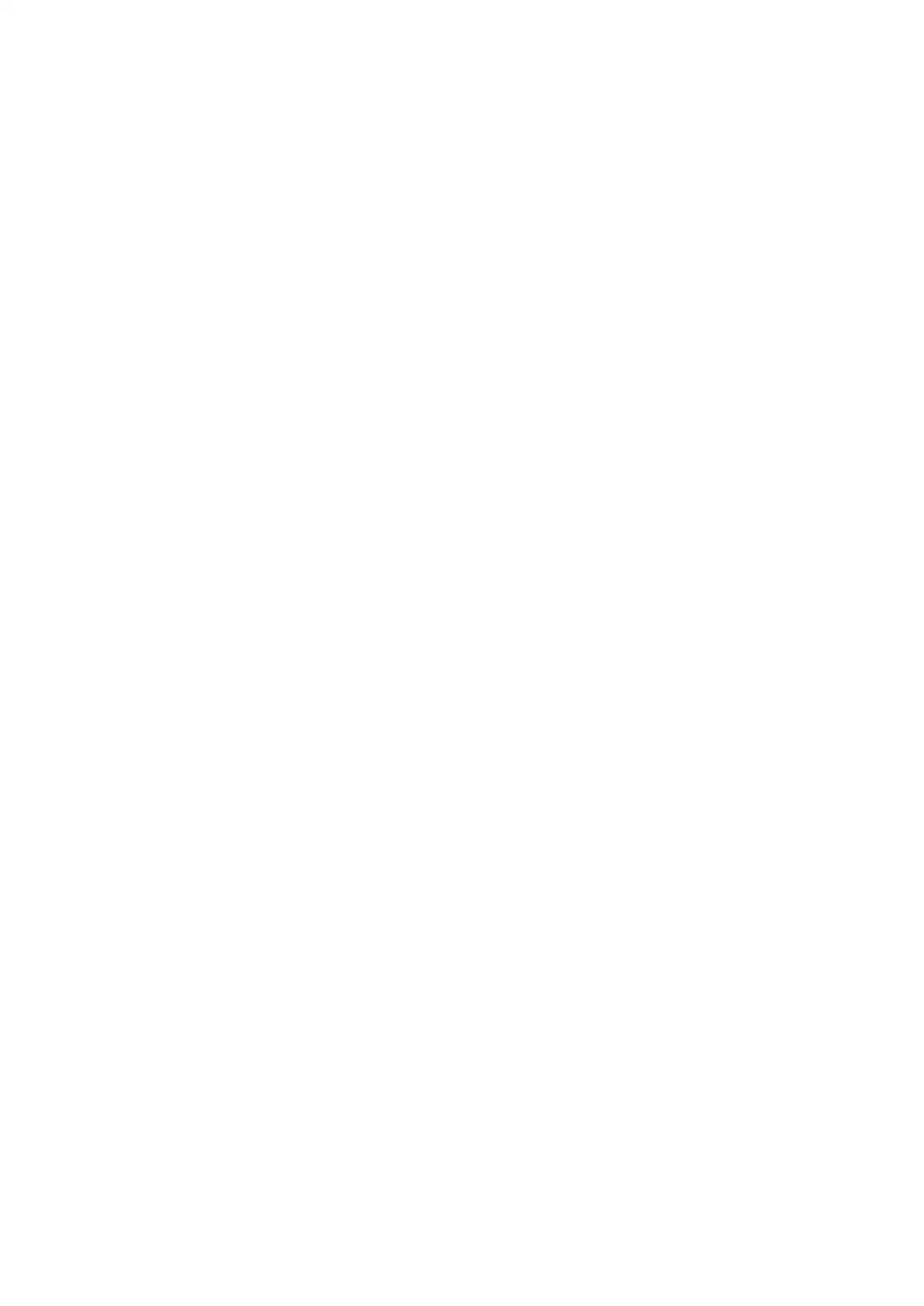
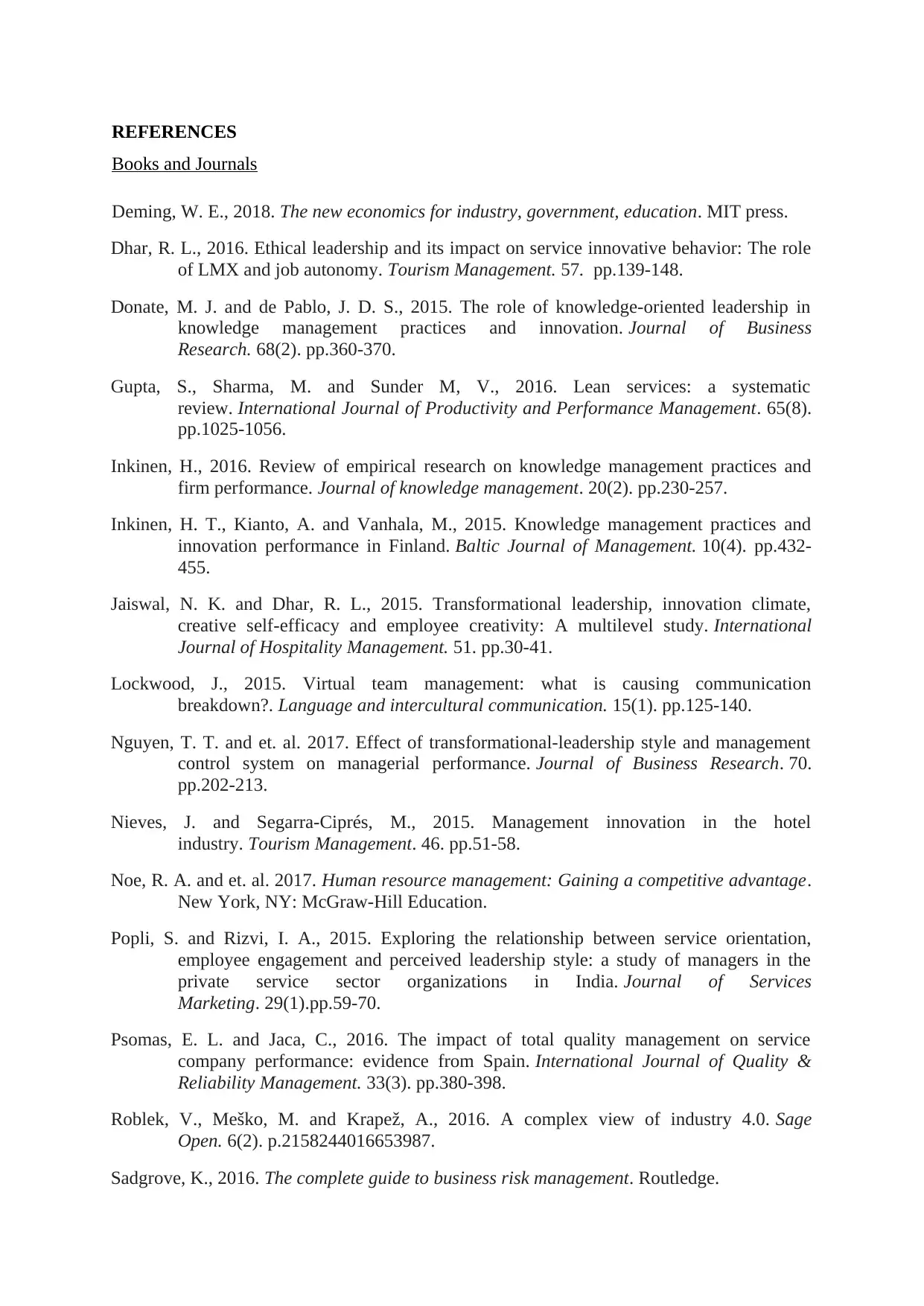
REFERENCES
Books and Journals
Deming, W. E., 2018. The new economics for industry, government, education. MIT press.
Dhar, R. L., 2016. Ethical leadership and its impact on service innovative behavior: The role
of LMX and job autonomy. Tourism Management. 57. pp.139-148.
Donate, M. J. and de Pablo, J. D. S., 2015. The role of knowledge-oriented leadership in
knowledge management practices and innovation. Journal of Business
Research. 68(2). pp.360-370.
Gupta, S., Sharma, M. and Sunder M, V., 2016. Lean services: a systematic
review. International Journal of Productivity and Performance Management. 65(8).
pp.1025-1056.
Inkinen, H., 2016. Review of empirical research on knowledge management practices and
firm performance. Journal of knowledge management. 20(2). pp.230-257.
Inkinen, H. T., Kianto, A. and Vanhala, M., 2015. Knowledge management practices and
innovation performance in Finland. Baltic Journal of Management. 10(4). pp.432-
455.
Jaiswal, N. K. and Dhar, R. L., 2015. Transformational leadership, innovation climate,
creative self-efficacy and employee creativity: A multilevel study. International
Journal of Hospitality Management. 51. pp.30-41.
Lockwood, J., 2015. Virtual team management: what is causing communication
breakdown?. Language and intercultural communication. 15(1). pp.125-140.
Nguyen, T. T. and et. al. 2017. Effect of transformational-leadership style and management
control system on managerial performance. Journal of Business Research. 70.
pp.202-213.
Nieves, J. and Segarra-Ciprés, M., 2015. Management innovation in the hotel
industry. Tourism Management. 46. pp.51-58.
Noe, R. A. and et. al. 2017. Human resource management: Gaining a competitive advantage.
New York, NY: McGraw-Hill Education.
Popli, S. and Rizvi, I. A., 2015. Exploring the relationship between service orientation,
employee engagement and perceived leadership style: a study of managers in the
private service sector organizations in India. Journal of Services
Marketing. 29(1).pp.59-70.
Psomas, E. L. and Jaca, C., 2016. The impact of total quality management on service
company performance: evidence from Spain. International Journal of Quality &
Reliability Management. 33(3). pp.380-398.
Roblek, V., Meško, M. and Krapež, A., 2016. A complex view of industry 4.0. Sage
Open. 6(2). p.2158244016653987.
Sadgrove, K., 2016. The complete guide to business risk management. Routledge.
Books and Journals
Deming, W. E., 2018. The new economics for industry, government, education. MIT press.
Dhar, R. L., 2016. Ethical leadership and its impact on service innovative behavior: The role
of LMX and job autonomy. Tourism Management. 57. pp.139-148.
Donate, M. J. and de Pablo, J. D. S., 2015. The role of knowledge-oriented leadership in
knowledge management practices and innovation. Journal of Business
Research. 68(2). pp.360-370.
Gupta, S., Sharma, M. and Sunder M, V., 2016. Lean services: a systematic
review. International Journal of Productivity and Performance Management. 65(8).
pp.1025-1056.
Inkinen, H., 2016. Review of empirical research on knowledge management practices and
firm performance. Journal of knowledge management. 20(2). pp.230-257.
Inkinen, H. T., Kianto, A. and Vanhala, M., 2015. Knowledge management practices and
innovation performance in Finland. Baltic Journal of Management. 10(4). pp.432-
455.
Jaiswal, N. K. and Dhar, R. L., 2015. Transformational leadership, innovation climate,
creative self-efficacy and employee creativity: A multilevel study. International
Journal of Hospitality Management. 51. pp.30-41.
Lockwood, J., 2015. Virtual team management: what is causing communication
breakdown?. Language and intercultural communication. 15(1). pp.125-140.
Nguyen, T. T. and et. al. 2017. Effect of transformational-leadership style and management
control system on managerial performance. Journal of Business Research. 70.
pp.202-213.
Nieves, J. and Segarra-Ciprés, M., 2015. Management innovation in the hotel
industry. Tourism Management. 46. pp.51-58.
Noe, R. A. and et. al. 2017. Human resource management: Gaining a competitive advantage.
New York, NY: McGraw-Hill Education.
Popli, S. and Rizvi, I. A., 2015. Exploring the relationship between service orientation,
employee engagement and perceived leadership style: a study of managers in the
private service sector organizations in India. Journal of Services
Marketing. 29(1).pp.59-70.
Psomas, E. L. and Jaca, C., 2016. The impact of total quality management on service
company performance: evidence from Spain. International Journal of Quality &
Reliability Management. 33(3). pp.380-398.
Roblek, V., Meško, M. and Krapež, A., 2016. A complex view of industry 4.0. Sage
Open. 6(2). p.2158244016653987.
Sadgrove, K., 2016. The complete guide to business risk management. Routledge.
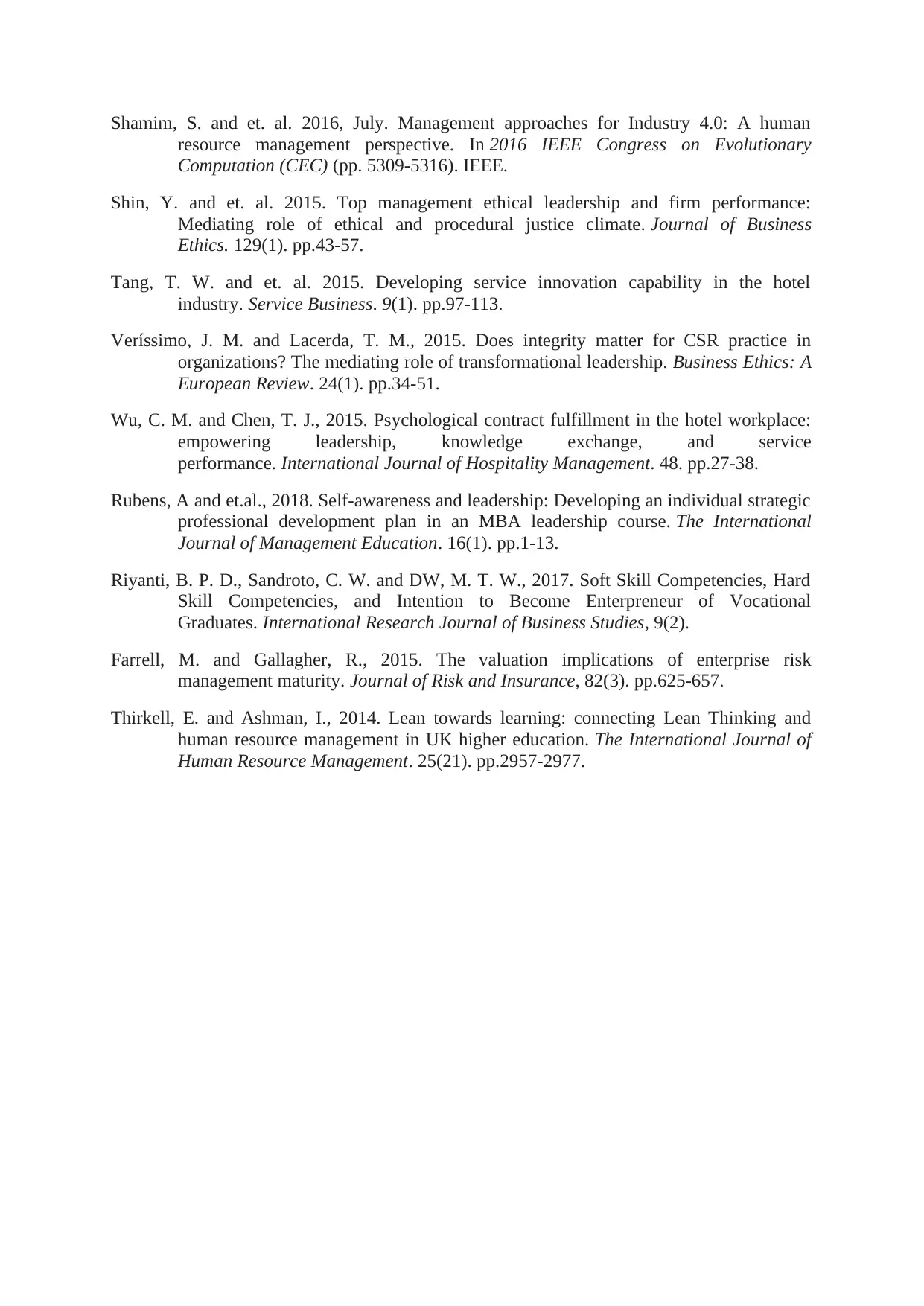
Shamim, S. and et. al. 2016, July. Management approaches for Industry 4.0: A human
resource management perspective. In 2016 IEEE Congress on Evolutionary
Computation (CEC) (pp. 5309-5316). IEEE.
Shin, Y. and et. al. 2015. Top management ethical leadership and firm performance:
Mediating role of ethical and procedural justice climate. Journal of Business
Ethics. 129(1). pp.43-57.
Tang, T. W. and et. al. 2015. Developing service innovation capability in the hotel
industry. Service Business. 9(1). pp.97-113.
Veríssimo, J. M. and Lacerda, T. M., 2015. Does integrity matter for CSR practice in
organizations? The mediating role of transformational leadership. Business Ethics: A
European Review. 24(1). pp.34-51.
Wu, C. M. and Chen, T. J., 2015. Psychological contract fulfillment in the hotel workplace:
empowering leadership, knowledge exchange, and service
performance. International Journal of Hospitality Management. 48. pp.27-38.
Rubens, A and et.al., 2018. Self-awareness and leadership: Developing an individual strategic
professional development plan in an MBA leadership course. The International
Journal of Management Education. 16(1). pp.1-13.
Riyanti, B. P. D., Sandroto, C. W. and DW, M. T. W., 2017. Soft Skill Competencies, Hard
Skill Competencies, and Intention to Become Enterpreneur of Vocational
Graduates. International Research Journal of Business Studies, 9(2).
Farrell, M. and Gallagher, R., 2015. The valuation implications of enterprise risk
management maturity. Journal of Risk and Insurance, 82(3). pp.625-657.
Thirkell, E. and Ashman, I., 2014. Lean towards learning: connecting Lean Thinking and
human resource management in UK higher education. The International Journal of
Human Resource Management. 25(21). pp.2957-2977.
resource management perspective. In 2016 IEEE Congress on Evolutionary
Computation (CEC) (pp. 5309-5316). IEEE.
Shin, Y. and et. al. 2015. Top management ethical leadership and firm performance:
Mediating role of ethical and procedural justice climate. Journal of Business
Ethics. 129(1). pp.43-57.
Tang, T. W. and et. al. 2015. Developing service innovation capability in the hotel
industry. Service Business. 9(1). pp.97-113.
Veríssimo, J. M. and Lacerda, T. M., 2015. Does integrity matter for CSR practice in
organizations? The mediating role of transformational leadership. Business Ethics: A
European Review. 24(1). pp.34-51.
Wu, C. M. and Chen, T. J., 2015. Psychological contract fulfillment in the hotel workplace:
empowering leadership, knowledge exchange, and service
performance. International Journal of Hospitality Management. 48. pp.27-38.
Rubens, A and et.al., 2018. Self-awareness and leadership: Developing an individual strategic
professional development plan in an MBA leadership course. The International
Journal of Management Education. 16(1). pp.1-13.
Riyanti, B. P. D., Sandroto, C. W. and DW, M. T. W., 2017. Soft Skill Competencies, Hard
Skill Competencies, and Intention to Become Enterpreneur of Vocational
Graduates. International Research Journal of Business Studies, 9(2).
Farrell, M. and Gallagher, R., 2015. The valuation implications of enterprise risk
management maturity. Journal of Risk and Insurance, 82(3). pp.625-657.
Thirkell, E. and Ashman, I., 2014. Lean towards learning: connecting Lean Thinking and
human resource management in UK higher education. The International Journal of
Human Resource Management. 25(21). pp.2957-2977.
1 out of 19
Related Documents
Your All-in-One AI-Powered Toolkit for Academic Success.
+13062052269
info@desklib.com
Available 24*7 on WhatsApp / Email
![[object Object]](/_next/static/media/star-bottom.7253800d.svg)
Unlock your academic potential
© 2024 | Zucol Services PVT LTD | All rights reserved.





